
September 21, 2023
Scitech Daily has the report here;
https://scitechdaily.com/scarlet-secrets-scientists-uncover-ancient-breeding-of-scarlet-macaws/

News Reports from the Ancient North American World

Scitech Daily has the report here;
https://scitechdaily.com/scarlet-secrets-scientists-uncover-ancient-breeding-of-scarlet-macaws/
May 10, 2023
November 22, 2022
Researchers led by a University of Texas at Austin team are finding out that thick billed parrots found at sites in the Southwest were captured locally and not all of them were imported from Mexico. They do not live in the US today due top habitat loss and hunting. They were abundant in the 1930’s in the Southwest from New Mexico to Arizona and northern Mexico. They live in pine forests. The researchers found that at the 10 sites where thick billed parrots have been found all had buildings made of pine timber. All had pine forests near by. They probably captured the parrots when they were gathering timber.
So the idea that all of the brightly colored parrots found in Southwest sites were from Mexico will change.
The research is published in The Wilson Journal of Ornithology.
Eurekalert has the report here:
October 21, 2022
A mile long canal built for canoe travel by Native Americans between 576-650 CE connected the Gulf of Mexico to Oyster Bay and Little Lagoon in Alabama. They built dams at both ends of the canal to guard against flooding of the canal. In the winter, canoes could traverse the distance to the Gulf. In the summer, it would have been a footpath through the forest.
Middle Woodland villagers, living at Plash Island, probably built the canal to get to camps closer to the Gulf to process, smoke and dry fish and shell fish for preservation. They were not agriculturists so this was crucial to their survival.
The canal would have also been a good conduit for long distance trade from Mobile Bay to the entire southeast. And there is no evidence for a chiefly elite during this time period. So an equalitarian effort was undertaken to build the canal and constantly clean the canal out and divvy up the water.
The research was published in the Journal of Field Archaeology.
The report is here at Smithsonian Magazine
October 21, 2022
Archaeologist Brad Lepper wrote an article about the influence of the Milky Way on the construction of Serpent Mound in Ohio for a special forum on cosmic influences on ancient construction. Serpent Mound represents the Great Serpent, Lord of the Underworld. In indigenous cultures, the Great Serpent is represented by the Milky Way.
Ohio has two effigy mounds, the Serpent Mound and the “Alligator” mound which represents the Underwater Panther. Wisonsin has thousands of effigy mounds built between 700-1150 CE by the Effigy Mound Culture.
Brad and his colleagues believe Serpent Mound is three separate mounds representing two figures, the Great Serpent and First Woman who is represented as a wishbone shaped mound with an oval earthwork representing her spread legs and the jaws of the Serpent. The oval is The First Woman’s womb which is the portal through which the Sun sets in the evening.
First Woman mated with the Great Serpent and acquired the Great Serpent’s powers of regeneration which she used to create all life.
Serpent Mound was built in 1100 CE by the Fort Ancient Culture who were also influenced by the Mississippian civilization centered at the site of Cahokia in Illinois
Brad Lepper is the Senior Archaeologist for the Ohio History Connection’s World Heritage Program
The forum articles are published in the Journal of Skyscape Archaeology
Columbus Dispatch has Brad’s research here:
October 21, 2022
Two grassy mounds located at Louisiana State University containing thousands of charred mammoth bones and with a cosmic alignment of both mounds towards a star are among 800 mounds of this type in Louisiana
Sediment cores have been taken from the two mounds and they found layers of burned ash from reed and cane plants and burned bone fragments in the cores. Radiocarbon dating show that the mounds were built 11,000 years ago, and built up over thousands of years. The 11,000 years ago date places these mounds as the oldest ever built in North America.
8,200 years ago, the earlier southern mound was abandoned in a cold period in the Northern hemisphere which lasted 150 years. 7,500 years ago they built a second mound and reworked the abandoned mound 6,000 years ago. The mounds were aligned with the giant star Arcturus.
The research is published in the American Journal of Science by Yale University.
More information: Brooks B. Ellwood et al, The LSU campus mounds, with construction beginning at ∼11,000 BP, are the oldest known extant man-made structures in the Americas
American Journal of Science (2022). DOI: 10.2475/06.2022.02
PhysOrg has the report here:
Researchers using paleoenvironmental analysis at the giant Mississippian site of Cahokia in Illinois, which exploded into prominence at 1050 CE and thrived for 300 years, was thought to have had four large plazas on the north, south, east and west which surrounded the very large temple known as Monk’s Mound, have found that the north plaza was almost always underwater. Cahokia was built on a flood plain beneath the confluence of the Missouri and Illinois Rivers.
The north plaza is built at the lowest elevation of the site. Two creeks ran through it and it flooded when the Mississippi swelled after heavy rains. The research team extracted sediment cores at the north plaza, took soil samples and analyzed carbon isotope in the soil and found that the area was wet all year. Water was important to Cahokia since they grew wetland plants and traded up and down the Mississippi. Their religious vision would probably have included water in their creation stories.
The chief researcher, Caitlin Rankin, from the Illinois State Archaeological Survey wrote the research paper on this find.
The National Geographic Society and National Science Foundation supported this work.
To reach Caitlin Rankin, email rankinc@illinois.edu
The paper “The exceptional environmental setting of the north plaza, Cahokia Mounds, Illinois, USA” is available online and from the U. of I. News Bureau. DOI: 10.1080/00438243.2022.2077824
news.illinois.edu has the report here;
Mike Ruggeri’s Ancient Cahokia https://mikeruggerisancientcahokla.tumblr.com

May 22, 2022
3D Scans Reveal Largest Cave Art in North America
Researchers have found mud drawings in a limestone cave in Alabama mad by torchlight bearing artists 1000 years ago. This is not of the largest rock art creations in North America. 3D photogrammetry was used to reveal the art. 5,000 square feet of art has been revealed by researchers lying down inside the cave chamber to 3-D the art. The artists would have done the same. There are thousands of engravings. Now that this discovery has been made, there will probably be others found.
3D photogrammetry IS an emerging technology that creates three-dimensional models based on overlapping photographs. The researchers used a digital camera, LED lights, and a photo rig alternatively set up on the dry cave floor or in patches of knee-deep water. They found 16.000 images.
Then it required uploading and processing each 50-megapixel photo into a larger 3D model. (The sheer amount of data “melted our first computer,” Alvarez says.)
Many of the figures are life sized. A rattlesnake drawing was 11 feet long, the largest piece of cave art ever found.
The drawing naked to the human eye date to 100 CE-1100 CE. This find shows that rock art in the Southwest was as large as rock art in the Southwest.
Researchers will be racing to find more such cave art work using this new technique. Just touching the art work can erase it.
National Geographic has the story here with many breathtaking photos;
April 10, 2022
The Hopewell Interaction Sphere was a social network that stretched across across eastern North America from CE 1-400. Seashells, copper, and mica and other raw materials were traded within this network. People within the network adopted copper ear ornaments and drilled bear teeth as cultural symbols. Drilled bear teeth were found in a field in eastern Kansas similar to teeth in Hopewell sites in Ohio and Illinois.
Recently, these teeth have been studied. There are 14 teeth in the collection from Kansas and they were made into a necklace. They will research whether these belonged to Ohio bears, and perhaps a pilgrim from Kansas obtained them from a Hopewell site. If they are Kansas bears, perhaps the necklace was made in imitation of bear necklaces seen by a Kansas pilgrim at a Hopewell site. But the fact that these were found in the Great Plains shows the extent of Hopewell influence.
The great Brad Lepper reported on this in the Columbus Dispatch;
https://www.dispatch.com/story/news/columns/2022/03/24/hopewell-influence-may-have-ranged-much-farther-west/7127569001/
Researchers studying the raising of turkeys in the Ancient Southwest found that turkeys were often penned in rooms like the room near Room 28 at Pueblo Bonito. Turkeys were also allowed free range tied to tethers for over 1,600 years in the Southwest and northwest Mexico. Turkeys were used for the creation of blankets, paints, tools, musical instruments, food, and art. They were fed maize and ate fresh range diets.
“The DNA of the Ancestral Pueblo domesticated turkey survives in some wild Merriam’s turkey populations within the Southwest. So, when you are hunting for turkeys in New Mexico, or simply experience them in the environment, there is likely an aspect of that turkey that is related to the birds, peoples, and experiences described in this research,” he noted, adding, “There is a direct connection between what we perceive as ‘wild’ turkeys within the environment today and their ancestors of the past who interacted with and were managed by Pueblo peoples. It makes this research important because it was the specific conditions in which Ancestral Pueblo peoples managed these birds that allowed for this current relationship.
Turkey Conrad, management of the ancient Pueblo Turkey (Meleagris gallopavo spp.), Journal of archaeological methods and theories (2021). DOI: 10.1007 / s10816-021-09531-9
Phys.org has the report here;
https://phys.org/news/2021-09-delves-role-turkeys-ancestral-pueblo.html
Researchers at Washington University, St. Louis have found that the inhabitants of Poverty Point in Louisiana 3,400 years ago were highly skilled engineers who could build massive earthen structures in months that lasted far into the future. Their earthworks have have held together for 3,000 years with no failure or erosion. They built 72 foot tall earthen mounds without modern tools, horses or wheels.
Using modern research methods: radiocarbon dating, microscopic analysis of soils and magnetic measurements of soils, the research provides conclusive evidence that the earthworks were built rapidly. Essentially, there is no evidence of boundaries or signs of weathering between the various levels, which would have occurred if there was even a brief pause in construction. This required a large labor force, organized and good leadership. These were hunter-gatherers coming together on a huge common goal. They mixed clay, silt and sand to avoid erosion due to being in a flood plain.
Phys.org has the report here;
In 1980, ancient cave art in the Southeast was found for the first time. The initial discovery was made in a cave near Knoxville, Tennessee. Since then, 92 dark-zone cave art sites have been discovered across the Mid-West and Eastern USA. The first cave art was named Mud Glyph Cave, and the art stretches back to 10,000-1000 BCE. The earliest are simple mostly abstract motifs, although some representational pictures have also been found there.
During the Woodland Period (1000 BCE-1000 CE) mythical creatures like bird-humans appear.
During the Mississippian Period (1000 CE-1500 CE) was the most prolific period with religious symbolism including spirits and mythical animals, and stories were being told.
Archaeologists are working with the present day Native Americans to discern the meanings of the art.
Archaeologists have divided south-eastern dark-zone cave art into three categories: mud glyphs, which are drawings traced into pliable mud surfaces preserved in caves; petroglyphs, which are drawings carved into the limestone of the cave walls; and pictographs, which are paintings on the cave walls, usually made with charcoal-based pigments. In some caves one can find two or even three of these categories.
Cherokee archaeologists, historians, and language experts have joined forces with archaeologists to translate these cave writings.
The dark-zone cave art is associated with death, transformation and renewal. They feature otherworldly characters, supernatural serpents and dogs that accompanied dead humans on the path of souls. The images are largely painted in black, a color associated with death.
https://edition.cnn.com/2013/06/20/us/tennessee-cave-art/index.html
Researchers have found the oldest human use of tobacco at a US Air Force base in Utah. Four charred tobacco seeds show that inhabitants of this site were chewing tobacco 12,300 years ago, 9.000 years earlier than previously thought. The seeds were found in an open air camp with a hearth, animal bones and stone tools. The camp is called Wishbone site because hundreds of bones of water fowl were found there, the main food source for these inhabitants.
The previous believed oldest tobacco find was in Alabama, where tobacco residue was found in a 3,300 year old smoking pipe. Tobacco would not have grown in the humid area where the seeds were found, so the seeds had to have been transported from elsewhere.
The seeds found at Wishbone belong to Nicotiana attenuata, the species of wild tobacco with the highest content of nicotine, thus the tobacco was selected out.
The people of Wishbone site belonged to the so-called Haskett culture. This was a stone tool complex that developed around 13,000 years ago
The tobacco at Wishbone may have had ceremonial value, or enjoyed for the energy and focus that a stimulant such as nicotine could provide to exhausted hunter-gatherers.
It’s also addictive, so in the end it would probably become part of your everyday life.
The research is published in the journal Nature Human Behavior,
Haaretz has the report here:
https://www.haaretz.com/archaeology/.premium-a-12-000-year-old-addiction-archaeologists-identify-earliest-tobacco-use-by-humans-1.10284266?utm_source=mailchimp&utm_medium=content&utm_campaign=haaretz-news&utm_content=7aae743808&fbclid=IwAR0SYczduPc7_jMfLouYt9JLe_dE_iuZQwucqNwkT3anoKEG9QXpvzYjqw8
October 12, 2021
Ancient human footprints at the White Sands site in New Mexico have been uncovered. They were pressed into a local plant, spiral ditch grass. The seeds of the plant were radio carbon dated at 21,000-23,000 years ago. Seven footprint sites have been found at the site. They may represent children and adolescents because their feet were smaller. Since these foot prints were made by people who lived during the last glacial maximum, they had to have arrived by sea by some route around the glaciers.
Scientific American has the report here;
https://www.scientificamerican.com/article/footprint-discovery-hints-at-humans-in-the-americas-more-than-20-000-years-ago/
The footprints were found in the dry land bed of Lake Otero. The footprints were found by the team of archaeologists studying the site on a day when wind exposed the prints;
Sci-news has that report here:
http://www.sci-news.com/archaeology/americas-oldest-known-human-footprints-10100.html
The team found six layers and 11 seedbeds that stretched for 2000 years. The oldest footprint being 22,800 years ago and the youngest at 21,139 years ago.
The erosion that has revealed the footprints will disappear in a matter of months or years. Countless footprints are disappearing before the scientists even lay eyes on them.
But there is one strong doubt that remains; The seeds could have absorbed older carbon from the lake water, making them seem older than they really are. That particular problem will have to be settled before this find can be labeled as genuine Pre-Clovis.
(My note; That problem and further testing often takes years to prove by other teams investigating the evidence. It took over 20 years for the Monte Verde site in Chile to be proven Pre-Clovis and many years before the Paisley Cave, Oregon find to be certified Pre-Clovis).
The NY Times has that report here:
https://www.nytimes.com/2021/09/23/science/ancient-footprints-ice-age.html?partner=IFTTT
Researchers in Michigan have found a 13,000 year old Clovis site, which is the oldest archaeological site in Michigan. The site was occupied by 6-7 people. They were hunter-scavengers living on the edge of the retreating mile high glacier at the end of the last Ice Age. Thomas Talbot found the first Clovis point there in 2008, in a field now known as the Belsen Site. The point was of Attica Chert that came from 120 miles away. Talbot found more pieces as the years went by, until he found 20 Clovis tools and a lot of debitage at the site.
A more extensive search of the site was carried out by University of Michigan archaeologists and found an undisturbed layer, and the camp. Protein residue analysis will now take place at a lab in Colorado to identify the plants and animals the points were used on.
The research has been published in the journal PaleoAmerican: • Study: The Belson Site: A Paleoindian Campsite on the Outwash Plains of the Central Great Lakes
The report is here from the University of Michigan;
https://news.umich.edu/farm-field-find-rewrites-archaeological-history-in-michigan/
Mike Ruggeri’s Ancient Americas News on Tumblr
http://michaelruggeriancientamericas.tumblr.com
An underwater archaeological team from the University of Texas, the University of Michigan, Lake Superior National Marine Conservation Area, the University of Missouri Research Reactor Center, the Northwest Research Obsidian Studies Laboratory and the University of Georgia have found 9,000 year old obsidian tools under Lake Huron that originated 2,500 miles away from the well-known Wagontire site in Central Oregon. These are the farthest east these western obsidian artifacts has ever been found.
This research was part of a study on caribou hunters at the end of the last Ice Age.
More information: John M. O’Shea et al, Central Oregon obsidian from a submerged early Holocene archaeological site beneath Lake Huron, PLOS ONE(2021). DOI: 10.1371/journal.pone.0250840
Phys.org has the report here:
https://phys.org/news/2021-06-underwater-site-team-year-old-stone.html
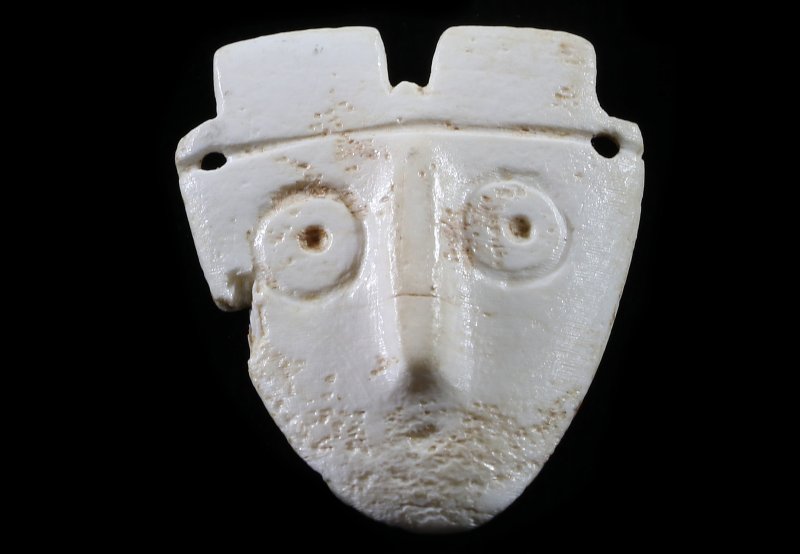
June 19, 2021
Recent archaeological research on the emergence of the Mississippian civilization posits that it was a combination of local styles and ideas mixed with the enormous influence of the capital of the Mississippian world, Cahokia. The diaspora of Cahokian people over time brought with it ceramics of their region, and their religious ideology based on the ordering of the cosmos.
Early on, around 1050 CE, they traveled north to present day Wisconsin spurring the creation of Cahokia style platform mounds at the sites of Trempeleau and Aztalan, as well as site layout and pottery
At the Carson site, downriver from Cahokia, Cahokian migrants built long, rectangular and semi-subterrenean houses that looked like home.
Cahokian emissaries carried distinctive tools, like the Burlington chert drill, far to the south, for making their tri-lobed projectile points.
Long-nosed god maskettes made of copper are found at 20 or so sites across the Southeast and Midwest, all of which have a Cahokian presence. These masks may have been part of a hero narrative that was also depicted in rock art and narrated by Siouxan speaking groups whose traditional lands encompassed much of the Upper Midwest.
Farther north, Cahokians created other new, hybridized styles with local populations.
At the Halliday site, in southern Illinois, 30 kilometers southeast of Cahokia; excavations have found nonlocal pottery types from Indiana and northern Mississippi, Tennessee and Arkansas, alongside pottery typical of Cahokia. People at Halliday were also eating slightly different foods than at other nearby sites, suggesting they maintained culinary traditions of their remote homelands.
Upland villages adopted a Cahokian building method that placed a prefabricated wall directly into a trench, but maintained their own building styles as well.
Cahokian and Mississippian culture are not one monolithic entity with just one perspective, but instead, a multitude of voices that together signified something greater.
The Conversation has the report here:
https://theconversation.com/cahokian-culture-spread-across-eastern-north-america-1-000-years-ago-in-an-early-example-of-diaspora-130106

June 19, 2021
Cahokians saw weather extremes and strong storms as spiritual transfers of power from the atmosphere to humanity. Pauketat linked this to the practice of Steam Bath Ceremonialism. Liquid water was converted into steam, and those in the steam bath absorbed the steam and its healing energy. Medicine bundles carried this idea to rural areas.
Pauketat sees the giant urban area of Cahokia, starting with the Big Bang of 1050 CE consisting of new architectural styles and lunar cycles. Shrines were expanded and causeways were constructed to make pathways to mounds with steam baths.
Throughout the 12th century, there was less rainfall precipitating dramatic changes. The migration of farmers began, defensive barriers were built, food supplies were concealed, and Steam Bath Ceremonialism declined.
More information: Timothy R. Pauketat, When the Rains Stopped: Evapotranspiration and Ontology at Ancient Cahokia, Journal of Anthropological Research (2020). DOI: 10.1086/711102
PhysOrg has the report here:
https://phys.org/news/2020-12-climate-catalyst-greater-cahokia.html
Mike Ruggeri’s Ancient Cahokia
https://mikeruggerisancientcahokla.tumblr.com
August 20, 2021
An underwater archaeological team from the University of Texas, the University of Michigan, Lake Superior National Marine Conservation Area, the University of Missouri Research Reactor Center, the Northwest Research Obsidian Studies Laboratory and the University of Georgia have found 9,000 year old obsidian tools under Lake Huron that originated 2,500 miles away from the well-known Wagontire site in Central Oregon. These are the farthest east these western obsidian artifacts has ever been found.
This research was part of a study on caribou hunters at the end of the last Ice Age.
More information: John M. O’Shea et al, Central Oregon obsidian from a submerged early Holocene archaeological site beneath Lake Huron, PLOS ONE(2021). DOI: 10.1371/journal.pone.0250840
Phys.org has the report here:
https://phys.org/news/2021-06-underwater-site-team-year-old-stone.html

June 19, 2021
New research shows that Cahokia was not abandoned because they cut down too many trees. Archaeologists from Washington University in St. Louis looked at the common narrative that the Cahokians deforested the area leading to erosion and flooding. The new team of researchers do not see evidence of flooding at the mound site they re-exacavated. In the journal Geoarchaeology, the researchers described their excavations at an earthen mound in the Cahokia Creek floodplain. The excavations showed that the ground surface of the mound remained stable until modern times. This directly challenges the wood overuse hypothesis.
Tens of thousands of trees were cut down to make palisades, but this did not cause local flooding says the team. Now new research is needed to explain the Cahokia collapse.
Washington University published their report here:
https://source.wustl.edu/2021/04/study-scant-evidence-that-wood-overuse-at-cahokia-caused-local-flooding-subsequent-collapse/?fbclid=IwAR2ILQgWSYTRkIo80nSjJPUvWx7iCM2QUnQcWknzn5TyI62wyAd_A2K9X5c
Mike Ruggeri’s Ancient Cahokia
https://mikeruggerisancientcahokla.tumblr.com
February 24, 2021
Hunter-gatherers on the California coast were using highly worked shell beads as currency 2000 years ago according to Lynn Gamble of the USC Santa Barbara. This changes our view of the political and economic complexity of hunter-gatherers.
Lynn’s research is published in “The origin and use of shell bead money in California” in the Journal of Anthropological Archaeology. She found that beads 1000 years before the beads accepted as money by archaeologists were found to be just as standardized as the newer beads, even more so. This is the kind used as money.
As Gamble notes, shell beads have been used for over 10,000 years in California, and there is extensive evidence for the production of some of these beads, especially those common in the last 3,000 to 4,000 years, on the northern Channel Islands. The evidence includes shell bead-making tools, such as drills, and massive amounts of shell bits — detritus — that littered the surface of archaeological sites on the islands.
Spanish colonizers were impressed by the Chumash trading networks and commerce facilitated by these beads.
This research pushes the use of money on the Pacific coast back 1000 years.
Ucsb.com has the report here;
https://www.news.ucsb.edu/2021/020161/ancient-economy
Mike Ruggeri’s Ancient North America News
https://mikeruggerisancientnorthamerica.tumblr.com
November 27, 2020
Researchers have deduced that rock paintings done by ancient Chumash people in Pinwheel Cave, California were setting the scene for tribal members going into a trance after taking the hallucinogenic plant datura, also known as jimson weed and angel trumpet. The paintings reference the shared tradition of taking that hallucinogen in that cave. The paintings look like an opening datura flower
Researchers knew the Chumash used datura for healing, to counter supernatural forces, for divination, to find lost objects, for medicine, and for coming of age ceremonies.
The researchers found quids stuffed into ceiling crevices. Quids are chewed all over the Ancient Southwest for nutrients or stimulants, including yucca, agave, tobacco. The quids at Pinwheel Cave were also chewed.
A chemical analysis revealed the presence of the Datura’s hallucinogenic compounds atropine and scopolamine, and a scanning electron microscope analysis further identified the quids as Datura, although one quid was made of yucca. The tribal members stuck chewed quids on to the ceiling. This cave was in use from 1600-1800 CE.. Projectile points and an arrow shaft straightener were found in the cave as well. There were ground seeds and animal remains indicating the cave was used for food preparation, storage and communal meals.
The research is published in the Proceedings of the National Academy of Sciences.
Live Science has the report here with photos:
https://www.livescience.com/rock-art-hallucinogen-california.html
Mike Ruggeri’s Moundbuilders/Ancient Southwest News on Tumblr
http://mikeruggerisancientnorthamerica.tumblr.com
November 23, 2020
A team of researchers at El Pais National Monument used radio carbon dating on charcoal found in an ice deposit in a lava tube. They found that Ancestral Puebloans (Anasazi) survived drought by traveling into the caves to melt ancient ice.
This was done between 150-950 CE. They started small fires to melt the ice. The researchers found clear evidence of five drought events.
The researchers focused on one lava tube, and this site is the earliest found so far for water harvesting in the Southwest. The tube is 171 meters long and 14 meters in depth. The fires they started left behind charcoal and ash deposits that is good for dating.
Researchers are soon going to lose data due to global warming melting the ice in the caves.
Below are the individuals and organizations who took part in the study, showing how international modern archaeology has become on these kinds of projects.
Joining in the exploration and research were Dylan S. Parmenter, whose master’s degree at USF was on the topic and is now a doctoral student at the University of Minnesota, Steven M. Baumann and Eric Weaver of the National Park Service, and Tiberiu B. Sava of the Horia Hulubei National Institute for Physics and Nuclear Engineering in Romania. The research was funded by the National Park Service and the National Science Foundation.
The research was published in Scientific Reports;
Science Daily has the report here;
https://www.sciencedaily.com/releases/2020/11/201118080741.htm
Mike Ruggeri’s Moundbuilders/Ancient Southwest News on Tumblr
http://mikeruggerisancientnorthamerica.tumblr.com
Colorado State archaeologists are continuing to study a site called High Rise village occupied 4000 years ago by the nomadic Shoshone people. This is one of the two dozen high elevation sites in the Wind River Mountains.
Alpine archaeology is a new field that was made possible by new and lighter equipment, In the 1960’s, miles of stone walls were found constructed to corral bighorn sheep. In the 1980’s, alpine villages at 12,000 feet were found in California, Nevada, and Colorado. It was long thought that these high altitude places were too hostile for sustained human occupation. Archaeologists are now trying to determine if people were driven there by population pressure or climate change.
Archaeology.org has the report here;
https://www.archaeology.org/issues/378-2005/features/8594
Mike Ruggeri’s Ancient Americas News on Tumblr
http://michaelruggeriancientamericas.tumblr.com
The inhabitants of Cahokia began to cultivate corn between 900-1000 CE. Corn cultivation spread from Mesoamerica to the Ancient Southwest at 4000 BCE.
Researchers determined the age of charred corn kernels in homes and shrines at Cahokia and also studied the carbon isotopes in the teeth and bones of humans and dogs. They found that corn consumption began abruptly at 950-1000 CE at Cahokia. At the same time, mound construction began at Cahokia. The population exploded and fertility iconography appeared.
The reason why corn cultivation started so late in the Mid-West was that it had to adapt to survive in a northerly climate.
The new research is published in American Antiquity;
Thomas E. Emerson et al, Isotopic Confirmation of the Timing and Intensity of Maize Consumption in Greater Cahokia, American Antiquity (2020). DOI: 10.1017/aaq.2020.7
PHYS.ORG has the report here;
https://phys.org/news/2020-05-cahokia-parallels-onset-corn-agriculture.html
Mike Ruggeri’s Ancient Cahokia
https://mikeruggerisancientcahokla.tumblr.com
Mike Ruggeri’s Ancient North America News
https://mikeruggerisancientnorthamerica.tumblr.com
Abstract highly decorated mud balls have been excavated at the ancient Poverty Point Site in Louisiana. They were baked to make them durable through the ages. The designs are abstract, and the patterns represent Spider webs, lotus pods, the sun, an owl. They are dated to 1700 BCE. Poverty Point inhabitants used cooking balls to prepare food, using them as hot rocks. These are different.
These decorated balls were made from soil as far away as the Tennessee River Valley and the Gulf Coast, hundreds of miles away. Were pilgrims bringing these balls to Poverty Point?
The Belleville News Democrat has the report here with a photo of the artifacts.
https://www.bnd.com/news/nation-world/national/article241821501.html
And the extensive research on this is at Researchgate;Poverty Point Objects Re-Considered;https://www.researchgate.net/publication/304610019_Poverty_Point_Objects_Reconsidered
For more on the ancient Poverty Point site;
https://michaelruggeri.com/THE_MISSISSIPPIAN_WORLD_AND_THE_MOUND_BUILDERS/MIKE_RUGGERIS_MISSISSIPPIAN_WORLD.html
The Calusa were a hunter/gatherer/fisher society in Florida and the island of Mound Key
New research indicates they captured and stored fish in walled structures called watercourses made of shell and sediments. They walled off parts of an estuary for short term holding before eating, smoking or drying the fish.
Remote sensing has revealed two large shell mounds, a grand canal, and two large watercourses. A marine highway of 2,000 feet long and 100 feet wide bisected the key. There was a yards long opening to drive fish into the enclosures which would be closed with a gate or net. These structures were built at 1300-1400 CE
The research was published in PNAS;
Victor D. Thompson et al. Ancient engineering of fish capture and storage in southwest Florida. PNAS, published online March 30, 2020; doi: 10.1073/pnas.1921708117
Sci-News has the report here.
http://www.sci-news.com/archaeology/calusa-watercourts-08288.html
Mike Ruggeri’s Moundbuilders/Ancient Southwest News on WordPress
https://mikeruggerismoundbuildersancientsouthwest.news.blog
Mike Ruggeri’s Ancient Mississippian World Magazine
http://bit.ly/1EhnzvE
Archaeologists at Berkeley, Caliifornia State University, University of Wisconsin-Madison, and Northeastern University have researched the idea that the ancient Mississippian center of Cahokia was depopulated by floods, droughts, and resource exhaustion by the 1400’s. They found that the Illinois Confederation of tribes continued to build communities around maize farming, bison hunting, controlled burning, living on small farms and gardens.
The research team studied fecal stanols of human waste in the sediment under Horseshoe Lake, Cahokia’s main catchment area. The levels of the stanols can gauge changes in population. The evidence points to migrations, warfare and ecological changes throughout the 1500s and 1600s in the area.
The research is published in the journal American Antiquity; Ancient poop helps show climate change contributed to fall of Cahokia the area
More information: A.J. White et al, After Cahokia: Indigenous Repopulation and Depopulation of the Horseshoe Lake Watershed AD 1400–1900, American Antiquity (2020). DOI: 10.1017/aaq.2019.103
Phys Org. has the report here
https://phys.org/news/2020-01-debunks-myth-cahokia-native-american.html
Mike Ruggeri’s Moundbuilders/Ancient Southwest News on Tumblr
http://mikeruggerisancientnorthamerica.tumblr.com
Mike Ruggeri’s Moundbuilders/Ancient Southwest News on WordPress
https://mikeruggerismoundbuildersancientsouthwest.news.blog
November 6, 2019
Archaeologists, using LIDAR technology, have uncovered a settlement dating to 900-1200 CE on Raleigh Island off the coast of northern Florida. They found 35 residential areas enclosed by edges of oyster shells. They found the inhabitants were making beads from mollusk shells as an important trade item. Past investigations of this area had been stymied by the dense foliage in the area. The shell borders are up to 12 feet high. Archaeologists have now embarked on 10 test digs at the sites. They have uncovered the tools that were used on the bead production.
The tribe that constructed these settlements were probably from the Tocobaga tribe who lived on the west coast of Florida from 900-1500 CE.
The settlement found on Raleigh Island is ‘unprecedented in its architecture, its scale of bead production, and its place in regional geopolitics,’
The beads produced on the island would have been exported to chiefdoms across much of the east and mid-west during the Mississippian era. They were worn as prestige items among the Mississippian elite.
Reports of this find are at Ancient Origins, Ars Technical’s and the Smithsonian;
https://www.ancient-origins.net/news-history-archaeology/settlement-florida-0012819
Mike Ruggeri’s Moundbuilders/Ancient Southwest News on WordPress
https://mikeruggerismoundbuildersancientsouthwest.news.blog
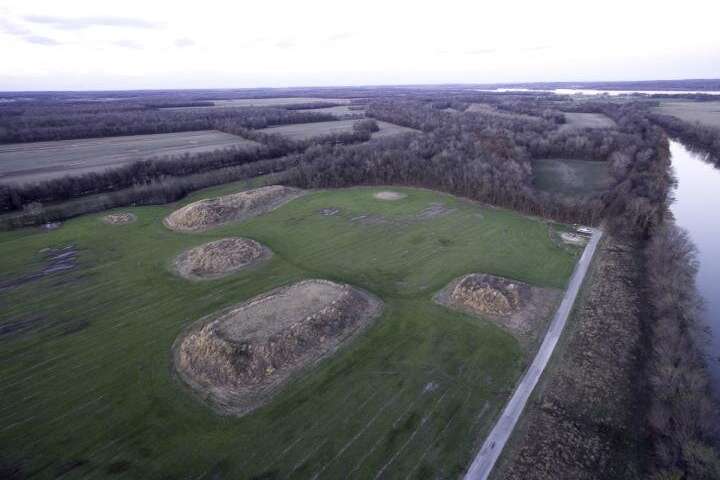
Researchers at the site of Kincaid Mounds and at the Avery Lake site (1150-1450 CE) found that the inhabitants of those site are responsible for 1.5 metric tons of lead pollution deposited in Avery Lake near the Ohio River. The lead came from galena deposits in southeastern and central Missouri and the upper Mississippi Valley. Galena is a lead sulfite mineral that is silvery and sparkly. It was ground and used to paint objects, buildings and personal adornments. Galena powder was blown into the lake or washed into the lake. The research shows that the galena trade was very large and that most of the pollution came from galena traded from other regions
Physical.org has the report here;
https://phys.org/news/2019-10-pollution-native-americans-attributed-galena.html
Mike Ruggeri’s Moundbuilders/Ancient Southwest News on Tumblr
http://mikeruggerisancientnorthamerica.tumblr.com
Mike Ruggeri’s Moundbuilders/Ancient Southwest News on WordPress
https://mikeruggerismoundbuildersancientsouthwest.news.blog
Archaeologists digging at St. Catherine’s Island off of the coast of Georgia have uncovered a copper object, and a 4000 year old grave site encircled by a massive ring of seashells. The burial practices and the copper object prove long distance trade more than 2000 years ago between the Great Lakes and the ancient Georgia coast. The authors claim this is the first clear evidence of this kind of trade and and exchange of religious ideas in eastern North America dating back to 2000 BCE.
Copper objects and other artifacts have been found at Poverty point in Louisiana dated to 1700 BCE. But those copper objects were obtained from only several hundred miles away.
The McQueen shell ring of Georgia is 70 meters across surrounding an earthen plaza. The earliest shell rings along the Atlantic and Gulf Coast date back to 3,800 BCE.
The new information pushes the known trade contacts between the upper Great Lakes and the Southeast coast back 2000 years in time.
Excavations in the center of the shell ring uncovered a burial pit filled with more than 80,000 ash-encrusted bone and tooth fragments, a copper band and remnants of stone tools. The copper tools have been analyzed and they are from Lake Superior. The copper band is dated at 3800-4300 years ago. The burial accompanied by copper bands and cremated individuals within resemble burials from the Great Lakes.
The Georgia site was probably a place for hosting hunter-gatherers on a seasonal basis. Fish, clams, oysters hickory and acorn nuts were founding the enclosure.
American Antiquity published the research.
Science News has the report
https://www.sciencenews.org/article/island-grave-site-hints-far-flung-ties-among-ancient-americans
Mike Ruggeri’s Ancient Southwest/Moundbuilders News on Word Press
https://mikeruggerismoundbuildersancientsouthwest.news.blog

Researchers at Chaco Canyon have carried out a detailed analysis of the climate and hydrology of the Chaco area and have found that its soil could not support the farming necessary to feed large populations. Dryland farming is impossible there due to lack of rainfall. Flash floods were also a constant source of destruction. Chacoans could only have farmed 100 acres, and could not have grown enough corn for over 1000 people. Deer and rabbits and small game would have been cleared out completely with 2,300 people to feed.
Importing food to feed 2,300 people from outside of the canyon would have required porters to make 18,000 trips by foot annually. So either Chacoans would have had to do this, or perhaps the structures in Chaco were only inhabited at times of pilgrimages from outside the canyon.
There research is published in the Journal of Archaeological Science.
And Colorado.edu has a report here
https://www.colorado.edu/today/2019/07/10/food-may-have-been-scarce-chaco-canyon
Mike Ruggeri’s Moundbuilders/Ancient Southwest News on Tumblr
http://mikeruggerisancientnorthamerica.tumblr.com
Mike Ruggeri’s Ancient Southwest/Mound Builders News Magazine
http://bit.ly/16PP9jH

In a new book on Cahokia agriculture, Gayle Fritz, professor emerita of anthropology in Arts & Sciences and author of “Feeding Cahokia: Early Agriculture in the North American Homeland” (2019 University of Alabama Press), has made it clear that the vast majority of Cahokia’s farmers were women. Their knowledge of agriculture gave them respect and power. Gayle Fritz is doubtful floods, drought or earthquakes brought down Cahokia. Food production at Cahokia was diversified, stable, and the land was in the Mississippi bottomland, the most fertile in America.
The female farmers of Cahokia grew bottle gourds, squash, sunflower, edible weeds like knotweed, maygrass, and chenopods. The genetics of these plants changed as the plants were domesticated. They also harvested hickory and acorns by introducing early crop protection methods, creating nut orchards. Modern flotation techniques have found that the over-reliance on maize story was not a true picture of Cahokia agriculture. When corn became a major crop at 900 CE, all of the other crops increased in abundance, and did not shrink.
Gayle Fritz also questions the ceramic figurines depicting women at Cahokia are not really “corn goddesses.” She points out that the plants on the figurines more accurately represent sunflower seed heads and squashes. And she questions the idea of a male dominated priesthood as the basis of Cahokia religion, given the importance of women.
Phys.org has the story here;
https://phys.org/news/2019-03-women-cuisine-culture-ancient-cahokia.html
Mike Ruggeri’s Moundbuilders/Ancient Southwest News on Tumblr
http://mikeruggerisancientnorthamerica.tumblr.com
Mike Ruggeri’s Ancient Mississippian Art, Religion, and Iconography Magazine
http://bit.ly/1zHFCGw
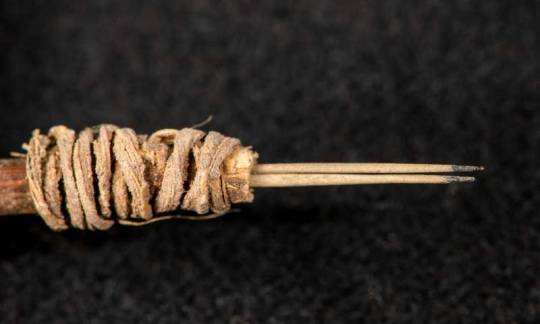
A Ph.D candidate at Washington State University found the oldest tattoo tool in North America when taking inventory of archaeological materials stored for more than 40 years. It is dated at 2000 years old. This pushes back the earliest evidence of tattoo tools in North America back 1000 years. The tool was from the Basketmaker II culture in the Southwest. No tattoos have been found on human remains in the Southwest and no accounts of its use have been recorded there. Earlier cactus tattoo tools have been found at 1100-1280 CE. There are depictions of tattooing in ancient artwork. The cactus tool that the student found was at a Utah site that is 1000 years older than the known cactus tools.
The tool consists of a 3 ½ inch wooden skunkbush sumac handle bound at the end with split yucca leaves and holding two parallel cactus spines, stained black at their tips.
The tool was put under an electron microscope, X-ray florescence and energy dispersive ray spectroscopy.
A research report has been published at; Andrew Gillreath-Brown et al, Redefining the age of tattooing in western North America: A 2000-year-old artifact from Utah, Journal of Archaeological Science: Reports (2019). DOI: 10.1016/j.jasrep.2019.02.015
Phys.org has the story here;
https://phys.org/news/2019-02-oldest-tattoo-tool-western-north.html#jCp
Mike Ruggeri’s Moundbuilders/Ancient Southwest News on Tumblr
http://mikeruggerisancientnorthamerica.tumblr.com
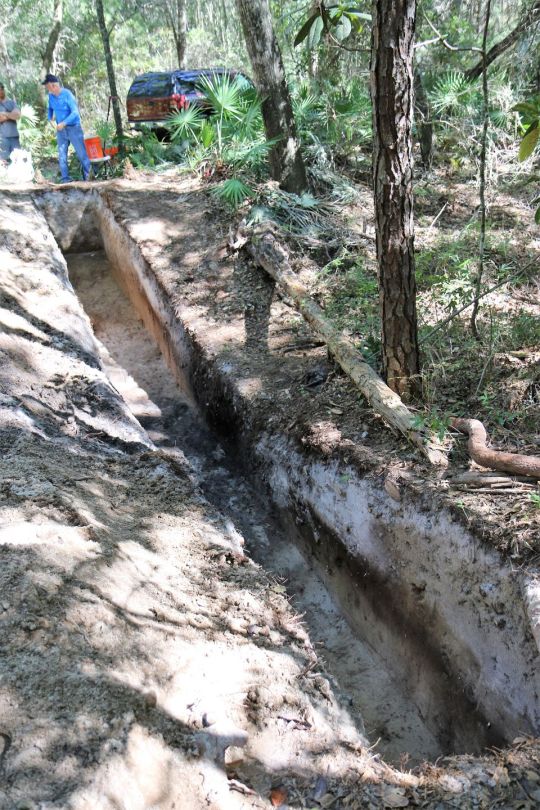
Archaeologists have uncovered an ancient canal in south Alabama dating to 600 CE. It facilitated canoe travel from Mobile Bay to the Gulf of Mexico. Similar canals have been found in the Everglades and south Florida. The newly uncovered canal connected two bodies of water rich in oysters, crabs, shrimp and fish. The canal was built during the Middle Woodland period, when there was a lot of earthwork and mound construction. A massive trade network spread across the North America, trading copper and silver from the Mid-West, Obsidian from Oregon, shells and teeth from the Gulf Coast. The canal saved travelers from walking through tangling vines and thorny shrubs in the area.
LIDAR and other scientific methods will now be used to find other parts of the canal.
al.com has the report here’
https://www.al.com/news/2019/02/ancient-native-american-canal-discovered-in-gulf-shores.html
Mike Ruggeri’s Ancient North America Newshttps://mikeruggerisancientnorthamerica.tumblr.com

Scarlet Macaws were traded from Mesoamerica to the Ancient Southwest for 2000 years. People at Chaco were importing macaws at 900 CE. A team of researchers at Penn State University has sequenced mitochondrial DNA from 14 ancient Scarlet Macaw remains from Mimbres and Chaco. Scarlet Macaws were bred at Paquime in Chihuahua for trade, but that was at 1250 CE. The team found that the Macaws from 900 CE we’re locally bred. So the Scarlet Macaw trade has to be a lot older than 900 CE.
So somewhere in Mesoamerica, there has to be a much older Scarlet Macaw breeding center that was trading with Chaco before 900 CE. The team found that scarlet macaws fall into seven genetic populations across the Americas. All 14 of the ancient macaws the team researched came form Haplogroup 6, so they were bred from the same stock. In an earlier article, Patricia Crown published in KIVA that traders walking from Mexico to Mimbres would be 11 to 12 weeks old. Paintings on Mimbres pottery show birds that are 8-10 weeks old. So it is very possible that that the birds arrived from an unknown site closer to Mimbres.
The research is published in the Proceedings of the National Academy of Sciences.
National Geographic has the report here;
https://www.nationalgeographic.com/science/2018/08/news-ancient-dna-chaco-canyon-pueblo-macaws-archaeology/
Mike Ruggeri’s Moundbuilders/Ancient Southwest News on Tumblr
http://mikeruggerisancientnorthamerica.tumblr.com
Mike Ruggeri’s Aztlan World
http://mikeruggerisaztlanworld.tumblr.com

Archaeologists found an ancient engraved smoking pipe in 1930 in Alabama. Researchers have now subjected the pipe to new scientific analysis using mass spectrometry. Clear traces of nicotine have been found inside the pipe. The pipe is dated to 1685-1530 BCE. This pushes back the earliest known use of tobacco for smoking by 1000 years. The research is posted in the Journal of Archaeological Science.
Science Magazine has the report here:
http://www.sciencemag.org/news/2018/06/americans-have-been-lighting-more-3000-years-ancient-pipe-reveals
(My note; This is not the first time tobacco has been found in the BCE era. In Utah, a site was uncovered that contained artifacts, including tobacco seeds, that dated to 10,000 years ago. No smoking pipes were found, but the presence of tobacco in that cache obviously raises the question, what were these folks doing with gathered tobacco seeds 10,000 years ago.)
Western Digs has that report here;
http://westerndigs.org/ice-age-hunting-camp-replete-with-bird-bones-and-tobacco-found-in-utah-desert/
Mike Ruggeri’s Ancient Americas News on Tumblr
http://michaelruggeriancientamericas.tumblr.com
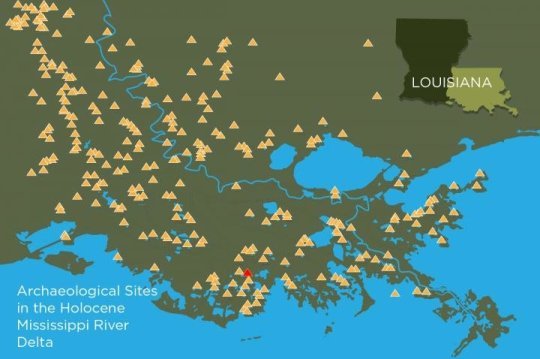
Archaeological researchers in Louisiana, using sediment coring, radiocarbon dating, carbon-isotope analysis, optically stimulated luminescence at the Grand Caillou mound are trying to find how ancient peoples in the area chose their village sites. The Grand Caillou Mound was built in stages over several hundred years, ending in 800 CE. The village construction began in 1200 CE. They confirmed that building the mound in layers with clay at the bottom, loose sediments in the middle and clay on top was a way that mound builders built mounds to withstand the elements.
Mound building in America began at 4,500 BCE near resource rich waterways. The Grand Caillou Mound village had a population of 500 people at a time. Ceramics there have been dated to 1000-1400 CE when the site was abandoned, due to saltwater incursion at the site over time.
The research appears in the Journal of Island and Coastal Archaeology
Science Daily has the report here;
https://www.sciencedaily.com/releases/2018/05/180522114822.htm
Mike Ruggeri’s Moundbuilders/Ancient Southwest News on Tumblr
http://mikeruggerisancientnorthamerica.tumblr.com
Mike Ruggeri’s Ancient Mississippian World Magazine
http://bit.ly/1EhnzvE

Spanish troops met a great Calusa leader at Mound Key, Florida in 1566. The king lived in a structure that could host 2000 individuals. The Calusa created a non-agricultural complex society based on fishing, hunting, and gathering. They ate sharks, turtles, shellfish, mullet, deer, birds, wild produce, and animals from the coasts, estuaries and mangrove forests. They grew chili peppers, papaya, and gourds in home gardens.
They developed a priesthood, military, canals, extensive trade routes, and tribute gathered from 20,000 people. Mound Key was an artificial island made from oysters and clam shells, topped with the huge royal house. The Spanish were forced to withdraw from the area after three years due to unending hostility. The Calusa burned down Mound Key. The Spanish did not return for another century. But Spanish diseases decimated their population. The remaining Calusa fled into the Florida Keys and Cuba by the end of the 18th century.
An archaeological team has reconstructed the outlines of the Calusa great house. It was oval shaped, 80 feet long and 65 feet wide, held up by 150 wooden posts. It was built in three stages starting in 1000 CE.
The research is published in the Journal of Anthropological Archaeology.
The report is in National Geographic;
https://news.nationalgeographic.com/2018/06/ancient-native-american-kings-house-found-florida-archaeology-science/
Mike Ruggeri’s Moundbuilders/Ancient Southwest News on Tumblr
http://mikeruggerisancientnorthamerica.tumblr.com
Mike Ruggeri’s Ancient Southwest/Mound Builders News Magazine
http://bit.ly/16PP9jH
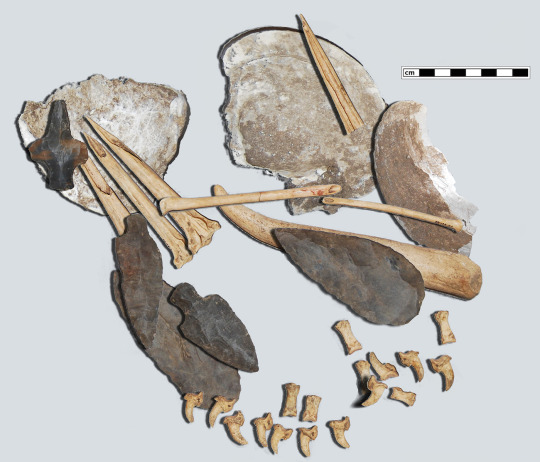
A tool kit dated at 1,600 BCE or older containing sharpened turkey bones and mussel shells were unearthed in 1985 in a Native American Cemetery in Tennessee. A pair of researchers took a look at the find beginning in 2013 to study it as an example of a possible medicine bundle. They saw the turkey bones as possible needles and the mussel shells as possible ink pots, when they saw red and black pigments on the shells. They referenced the work of a researcher in Montreal who tattooed pig skin with pre-historic tools to see the markings it left on the tools. They looked at the artifacts under microscopes and found a bright polish at the tip and saw the same wear patterns as the pigskin tattoo.
The evidence that this is a tattoo kit is now clear. And this would make the Tennessee find the oldest tattoo kit ever found in the world. The previous oldest kit was found at a Lapita site in the Solomon Islands using obsidian pieces dated at 1000 BCE,
Hyperallergenic.com has the story here;
https://hyperallergic.com/438579/worlds-oldest-tattoo-kit-fernvale-native-american/
Mike Ruggeri’s Ancient North America News
https://mikeruggerisancientnorthamerica.tumblr.com

The prehistoric Caddo village of Crenshaw in southwest Arkansas has a burial ground that contains at least 114 human skulls and 238 additional jawbones, but no bodies. A new theory about the remains is published in the Journal of Archaeological Science. The burial contains the remains of those who lived in the village or farming areas nearby. The jaws and skulls were possibly returned to the village for ceremonial burials. This would have been easier than transporting full bodies. Crenshaw was inhabited from 700-1400 CE. The remains are dated to 1253-1399 CE. The data was drawn from a study of lead isotopes in the dental remains of the buried.
ArkansasOnline has the report here;
http://www.arkansasonline.com/news/2018/apr/22/researcher-digs-into-ancient-caddo-myst-1/?f=news-arkansas
Mike Ruggeri’s Moundbuilders/Ancient Southwest News on Tumblr
http://mikeruggerisancientnorthamerica.tumblr.com

INAH has uncovered a 2000 year old mummified macaw at a cave at Avendaños ejido in San Francisco de Borja, in Chihuahua. This is the oldest example of this type of macaw ever found in Northern Mexico or the Southwest. INAH is joined in ancient macaw research by Penn State University and the University of Oklahoma. Strontium and DNA research is being done on all the ancient macaws in the Southwest, and now the Avendanos Cave, to determine how many of the macaws came from Paquime and how many from the rest of Mesoamerica.
So far, 670 skeletal remains of macaws have been found along with feathers of macaws. 504 came from Paquime as trade items. The rest were from the ancient Southwest sites of Chaco, Grasshopper, Turkey Creek, Salado, Gila Cliff, Kiet Siel, Sinagua-Wupatki, Pueblo Grande and Snaketown, among others. 90% are red macaws and 10% are military macaws. The newly discovered macaw is the first to be found in Mexico outside of Paquime. The macaw trade spanned 800 CE-1400 CE. The newly discovered macaw may be 800 years earlier than any ancient trade macaws that have been found in the Southwest or Mexico, if confirmed by carbon-14 dating.
INAH has the report here (in Spanish) with a great slide show of the cave, and the artifacts in the cave (click on the small green camera icon to see the slides).
http://www.inah.gob.mx/es/boletines/6856-datan-en-2000-anos-de-antigueedad-cabeza-momificada-de-guacamaya-hallada-en-cueva-avendanos-chihuahua
Mike Ruggeri’s Aztlan World
http://mikeruggerisaztlanworld.tumblr.com
Mike Ruggeri’s Casas Grandes World Magazine
http://bit.ly/1ztd8vF
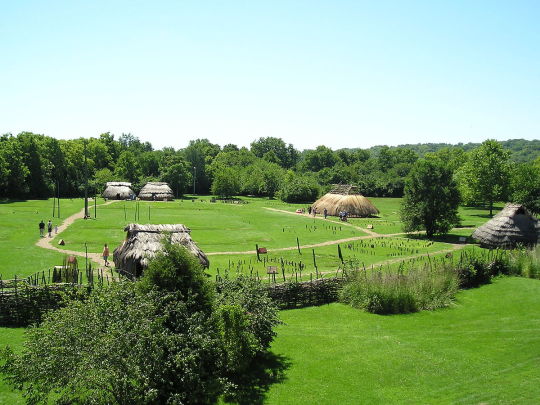
The Fort Ancient culture lived in southern Ohio and parts of Indiana, Kentucky and West Virginia between A.D. 1000 and 1650. They lived in large villages, grew maize in their gardens, and made distinctive pottery and arrowheads.
Robert Cook, an archaeologist at Ohio State University, in his new book “Continuity and Change in the Native American Village: Multicultural Origins and Descendants of the Fort Ancient Culture,” presents a new interpretation of the Fort Ancient Culture.
He posits that the Fort Ancient Culture developed rapidly as a result of the “Big Bang” that took place in Mississippian cultures that were centered at Cahokia in 1050 CE.
Analysis of human remains at Fort Ancient sites show that some of the people there came from the vicinity of Cahokia, bringing new religious ideas and design ideas with them. Fort Ancient sites at 1050 CE were the largest of the culture with the highest maize consumption, Mississippian artifacts and migrants. Climate change and pressure from the Iroquois led them to abandon their sites at the end of their culture.
The great Brad Lepper reports on this in the Columbus Dispatch;
http://www.dispatch.com/news/20171203/archaeology-cultural-big-bang-helped-form-fort-ancient-society
Mike Ruggeri’s Adena and Hopewell World
http://adenaandopewell.tumblr.com
Mike Ruggeri’s Adena, Hopewell, and Fort Ancient Cultures Magazine
http://bit.ly/1966ruf
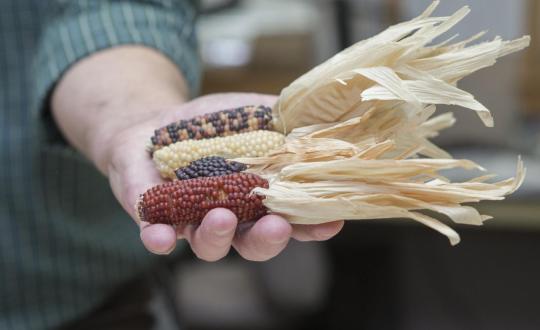
A University of Cincinnati archaeologist has taken a look at the supposition that people in the Ancient Southwest between 900-1200 CE were dependent on corn and is taking issue with it. He has taken a look at 2000 sites where pottery and other artifacts have been found and sees very little evidence of any dependence on corn.
He has spent two decades leading field research in the Grand Canyon National Park and the upper basin in the region. His evidence shows the ancient people of the area used fire to promote the growth of edible leaves, seeds, and nuts like amaranth, goosefoot, and chenopodium, wild relatives of quinoa, and calorie rich nuts and berries. Researching thousands of clay pots, he and his students have found 6000-7000 pollen grains and only six were corn. He also found that there was more evidence of wild edible plants then when people left these sites. He also looked at the area after a massive wild fire in 2016, and edible plants were growing there a month later in abundance.
This is not to say that other people in the Ancient Southwest were not more dependent on corn. There is more evidence for it outside of the area in question.
(My note: It seems to me that the same techniques used in this study should be applied elsewhere in the Southwest to test whether corn dependency is as prevalent as we have thought).
Eurekalert has the report here:
https://www.eurekalert.org/pub_releases/2017-11/uoc-asf112717.php
Mike Ruggeri’s Ancient North America News
https://mikeruggerisancientnorthamerica.tumblr.com
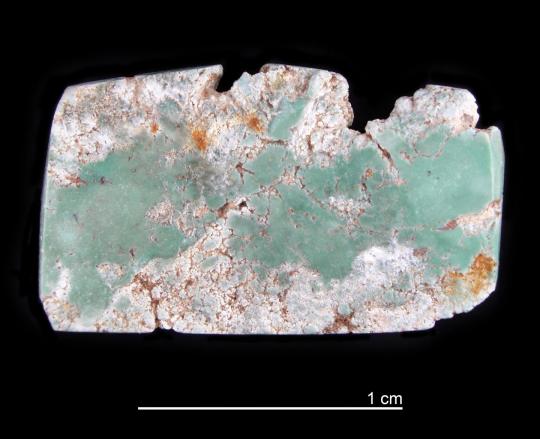
Researchers in Arizona have found that Pre-Columbian turquoise mining at the Canyon Creek mine, on the White Mountain Apache Indian Reservation, was larger than thought in intensity. They found through isotopic analysis of the Canyon Creek turquoise that it has ratios of lead and strontium isotopes unique from other Southwest turquoise. Scientists can now determine where turquoise was mined using these new techniques. They also found that the site was mined between 1250-1400 CE. This new science will help in studying ancient turquoise trading routes. Researchers are now using the same techniques to study the turquoise found at Tenochtitlan, the Aztec capital in Mexico. They may be able to determine the exact location of the mine the turquoise came from in the Southwest, and advance the study of Southwest/Mesomerica trading networks.
The research is published in the Journal of Archaeological Science,
Eurekalert has the story here:
https://www.eurekalert.org/pub_releases/2017-10/uoa-rsn101817.php
Mike Ruggeri’s Aztlan World
http://mikeruggerisaztlanworld.tumblr.com
Mike Ruggeri’s Casas Grandes World Magazine

Hundreds of shell ornaments have been found in the La Playa and Cerro de Trincheras areas of Sonora, Mexico. And they are similar to those found in Hohokam communities in Arizona.
Cerros de Trinchera was built on the side of a high hill with a central plaza, and walls in the shape of a snail shell spiral. The shell ornaments produced there were worked from 2,800 BC to 1400 AD. INAH and the University of Binghamton researchers have found seven kilograms of sea shells there worked into rings and bracelets with geometric motifs.
The La Playa site had 10,000 years of occupation. Shell ornamentation began there at 850 BCE-200 CE. This jewelry has not been found in burials in the area, so they were trade items sent to people further north and west. They worked shells into hoops worn as bracelets, which were worn by individuals all over northwest Mexico and the Southwestern US. The shell jewelry was exchanged for Paquime pottery and pottery from Arizona and New Mexico.
INAH has the report here (in Spanish) with a beautiful slide show of the jewelry. (Click on the tiny camera icon above the article to see the slide show,)
http://www.inah.gob.mx/en/boletines/6466-brazaletes-de-conchas-daninas-dan-identidad-a-los-pueblos-de-deierto-de-sonora
Mike Ruggeri’s Aztlan World
http://mikeruggerisaztlanworld.tumblr.com
Mike Ruggeri’s Casas Grandes World Magazine
http://bit.ly/1ztd8vF

A new generation of Chaco Culture studies is underway. The impetus for this is a study of a burial at Pueblo Bonito, which included turquoise, shell, and the skeleton of a man buried there between 800-850 CE. Boxes of human bones from Chaco were packed away and carted to various museums decades ago. A researcher is now re-uniting the bones into whole bodies again. As the skeletons were re-assembled, signs of disease like syphilis and TB have been uncovered. Bodies were manipulated with bones placed in very unusual ways.
Recent research concludes that a dynasty based on a maternal line ruled at Chcaco for 330 years, and recent research also points to the idea that the local inhabitants built the large Chaco structures, and not more experienced outsiders. Individuals with six toes were apparently very important as evidenced in the Chaco art work. There is clear evidence of Chaco trading 2000 miles to the south and 50 miles to the west and south.
Room 33 at Pueblo Bonito shows individuals, probably rulers, were buried in layers over 300 years in time. The dates for the emergence of complex society at Chaco have now been pushed back to 900 CE, 200 years earlier than thought. Dental analysis from 61 individuals at Pueblo Bonito shows that folks there were eating plants, animals and water from local sources. This strengthens the idea that the local Chacoans built their own complex society. Wood for the structures came largely from the Zuni Mountains, 75 kilometers to the south, and the Chuska Mountains, about the same distance to the west of Chaco Canyon, provided 70 percent of the more than 240,000 trees that were used for roof beams, doorframes and other features of Chaco great houses. Residue on Pueblo Bonito jars and pitchers comes from a chocolate beverage made from cacao that grew in Mesoamerica. Scarlet macaws from Mesoamerica appear at Chcao at 800 CE.
Once Chaco collapsed in 1300 CE, the people lived in small communities around clans based on maternal descent.
Earlier reports on all of these findings can be found at my web sites;
Mike Ruggeri’s Aztlan World
http://mikeruggerisaztlanworld.tumblr.com
Mike Ruggeri’s Casas Grandes World Magazine
http://bit.ly/1ztd8vF
Science News has the report here;
https://www.sciencenews.org/article/chaco-canyons-ancient-civilization-continues-puzzle

Macaw skeletons in three pueblos in New Mexico show signs of feather harvesting. Macaw feathers have been found all the way north to Utah at sites dating from 300-1450 CE. There is little evidence of macaw breeding in the Southwest. So the birds were imported from Mesoamerica. Researchers found that the macaw bones in the three pueblos show multiple feather loss the entire length of both wings. Thus the feathers were being harvested. Evidence of hand feeding and great care for the birds also showed up in the study. Chaco had an aviary with a 25 centimeter layer of guano. Macaws lived at Chaco around 1050-1120 CE. They saw the birds as tied to the underworld and rain bringers. So the birds were carefully cared for beyond the need for feather harvesting.
Nature.com has the report here;
http://www.nature.com/news/prehistoric-native-americans-farmed-macaws-in-feather-factories-1.21803
Mike Ruggeri’s Aztlan World
http://mikeruggerisaztlanworld.tumblr.com
Mike Ruggeri’s Casas Grandes World Magazine
http://bit.ly/1ztd8vF
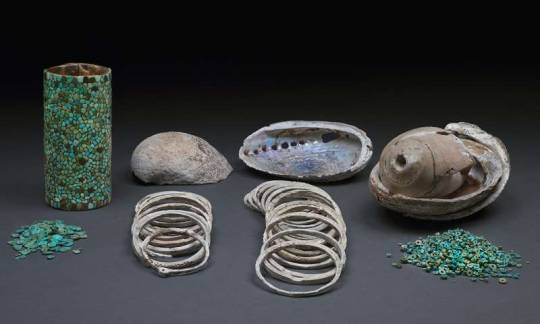
Researchers have found that the Chaco Canyon elite in New Mexico descend from a matrilinear dynasty. Researchers used DNA studies and radio carbon data to investigate the first elite tomb at the Pueblo Bonito structure at Chaco. The initial burial was of a male in his late 40s who died from a blow to his head. He was buried with 1,000 turquoise beads, 3,300 shell beads and other artifacts including abalone shells and a conch shell trumpet originating from the Pacific Ocean and Gulf of California. This is the richest burial ever found in the Southwest. 12 more burials, spanning 300 years, were found on a floor above. All of the buried shared the same mitochrondial DNA, so inheritance was through the mother. So one kinship group controlled Pueblo Bonito for more than 300 years,
Douglas J. Kennett et al, Archaeogenomic evidence reveals prehistoric matrilineal dynasty, Nature Communications (2017). DOI: 10.1038/ncomms14115
Phys.org has the report here;
https://phys.org/news/2017-02-radiocarbon-dating-dna-ancient-puebloan.html
Mike Ruggeri’s
The Ancient Southwest
http://bit.ly/X1kCou
Mike Ruggeri’s Ancient Southwest Magazine
http://bit.ly/1AU3vwE
Mike Ruggeri’s Ancient Southwest/Mound Builders News Magazine
http://bit.ly/16PP9jH
Mike Ruggeri’s Moundbuilders/Ancient Southwest News on Tumblr
http://mikeruggerisancientnorthamerica.tumblr.com
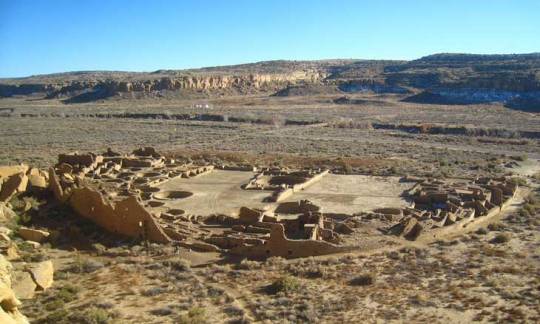
Researchers at Chaco have analyzed 60 sets of human remains at the Chaco site in New Mexico. The remains were found at the Pueblo Bonito structure of the site. These were elite burials with turquoise, pendants and pottery found in the graves. The researchers found that the vast majority were from Chaco Canyon, and not from more distant areas as many experts thought. So the Chaco phenomenon was brought about by the original settlers in the area. Isotope analysis was done on the teeth of these remains, which are scattered in museums throughout the US. The researchers found that the population of the elite was very homogeneous. There were 3 outliers that still have to be studied further to see where they may have come from among the 61 studied. The remains also exhibit cranial deformation, a sign of elite status throughout the Americas.
The team reports their findings in The Journal of Archaeological Science: Reports.
Price, T., Plog, S., LeBlanc, S., & Krigbaum, J. (2017). Great House origins and population stability at Pueblo Bonito, Chaco Canyon, New Mexico: The isotopic evidence Journal of Archaeological Science: Reports, 11, 261-273 DOI: 10.1016/j.jasrep.2016.11.043
Western Digs has the report here;
http://westerndigs.org/chacos-elites-were-native-to-the-canyon-not-migrants-their-remains-show/
Mike Ruggeri’s
The Ancient Southwest
http://bit.ly/X1kCou
Mike Ruggeri’s Ancient Southwest Magazine
http://bit.ly/1AU3vwE
Mike Ruggeri’s Ancient Southwest/Mound Builders News Magazine
http://bit.ly/16PP9jH
Mike Ruggeri’s Moundbuilders/Ancient Southwest News on Tumblr
http://mikeruggerisancientnorthamerica.tumblr.com

Researchers at Cahokia had theorized that the large Mississippian sites, including Cahokia, began to build during an unusually warm period and began to decline during the Little Ice Age. New research on ancient layers of calcite crystals in layers of mud in an Indiana lake show that the Mississippi Valley began to get more rain in the 10th century, when corn began to thrive at around 950 CE, as shown in the skeletal remains at the time. Cahokia began to explode with growth at the time. Around 1200 CE, a new Ice Age began with drought at 1350 CE. This lasted for 500 years. Large conflicts began at 1250 CE, with more palisades being built, burned villages, more skeletal injuries like decapitation. Mississippians began to abandon their cities and moved south. A contributing factor would have been in-migration of different groups into the large centers like Cahokia in the good times. When the droughts began, migrant infighting may have also contributed to the collapse.
NPR has the story here;
http://n.pr/2kAkzV6
Mike Ruggeri’s Mississippians and Mound Builders
http://bit.ly/XX6RGc
Mike Ruggeri’s Ancient Mississippian World Magazine
http://bit.ly/1EhnzvE
Mike Ruggeri’s Ancient Mississippian Art, Religion, and Iconography Magazine
http://bit.ly/1zHFCGw

The bones of horses. bisons, mammoths and other remains at Blufish Cave in the Yukon Territory excavated decades ago placed the bones at 25,000 years old. Anthropologist Lauriane Bourgeon at the University of Montreal believes a few of these bones show clear evidence of human cut marks on the bones of a dozen of the remains. This human cut mark theory was first proposed in 1977. The area of the bones were part of a land mass called Beringia, east of the Bering Strait. This goes further to proving what is called the “Beringian Standstill.” The theory is that a genetically isolated human population lived in Beringia before the last Ice Age. And they moved into the Americas from there, once the ice in front of them receded. The team studied 36,000 bones in the caves using high tech equipment.
15 of the bone samples prove human butchery says the research. The oldest sample with this find was dated at 24,000 years ago. The research is published in PLOS One journal.
Bourgeon, L., Burke, A., & Higham, T. (2017). Earliest Human Presence in North America Dated to the Last Glacial Maximum: New Radiocarbon Dates from Bluefish Caves, Canada PLOS ONE, 12 (1) DOI: 10.1371/journal.pone.0169486
(My Note; Cut mark evidence in the absence of any other human evidence is not always reliable many archaeologists maintain. Lauriane Bourgeon does state that this is just a beginning theory that has to be buttressed by other evidence such as human DNA evidence. So much more research has to be done. And many questions remain in Pre-Clovis science. Did the inhabitants of Beringia enter the Americas before any other groups? Are they related to the Pre-Clovis folks that lived at Monte Verde in Chile or the Pre-Clovis folks who utilized Paisley Cave?)
Western Digs has the report here;
http://westerndigs.org/bones-in-yukon-cave-show-humans-in-north-america-24000-years-ago-study-says/
Mike Ruggeri’s Pre-Clovis World
http://preclovisworld.tumblr.com
Mike Ruggeri’s Pre-Clovis and Clovis World Magazine
http://bit.ly/1uAWdvk
Mike Ruggeri’s Pre-Clovis and Clovis News on Tumblr
http://mikeruggerispreclovisnews.tumblr.com
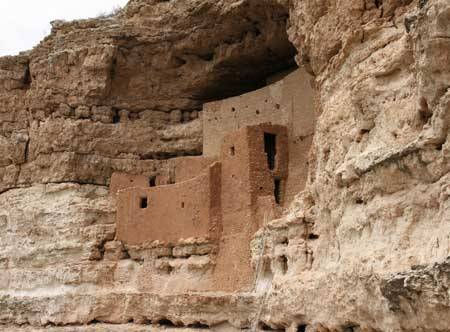
New evidence at Montezuma Castle, inhabited by the Southern Sinagua culture at 1100 CE-1300 CE, shows the final days of the cliff site may have been violent. 80 years ago, archaeologists found evidence of massive fires in both structures at the site. Building A at the site was found to have been burned between 1375-1395. Jeddito Yellow and Jeddito White pottery was being made right up to the end. A new examination of four dead from the site shows cut marks on their bones, burn marks and three skulls were fractured. Their bones were burned while they were still alive. It appears that the site was burned suddenly as part of a violent attack. The Native American oral histories of this event match the new findings.
The findings are published in the journal Kiva.
Guebard, M. (2016). During the Migration Time: Oral History, Violence, and Identity in the Prehistoric Verde Valley KIVA, 82 (3), 259-277 DOI: 10.1080/00231940.2016.1208632
Western Digs has the report here;
http://westerndigs.org/new-evidence-reveals-violent-final-days-at-arizonas-montezuma-castle/
Mike Ruggeri’s
The Ancient Southwest
http://bit.ly/X1kCou
Mike Ruggeri’s Moundbuilders/Ancient Southwest News on Tumblr
http://mikeruggerisancientnorthamerica.tumblr.com

3,000 year old Clay figurines found at two sites in Arizona appear to be fertility symbols. They may be the earliest clay figurines ever found in the Southwest. The artifacts were dated to the Early Agricultural period, 1.800-3,500 years ago in the Sonoran desert. Bone and antler material was found with the figurines at one site. The figurines have prominent sexual traits, looking phallic and also some with breasts. They may be dualistic.
The research is published in the Journal Kiva.
Western Digs has the report here with photos;
http://westerndigs.org/earliest-known-clay-figurines-in-the-southwest-may-be-fertility-symbols-study-says/
Mike Ruggeri’s Moundbuilders/Ancient Southwest News on Tumblr
http://mikeruggerisancientnorthamerica.tumblr.com
Archaeologists have found that the Pueblo people bred turkeys as far back as 200 BCE during the Basketmaker II era from 400 BCE-500 CE. They were used as a food source and for turkey feathers for blankets. Archaeologist Bill Lipe said that turkeys were primarily eaten at feasts and ritual gatherings. Later in Pueblo history, deers were being hunted out and replaced by turkeys. Archaeologists see that deer bones were being replaced by turkey bones as time went on. Lipe says that raising one turkey a year would require diverting lots of maize to raise the turkey. Turkey consumption peaked in the 1200’s, followed by depopulation. Perhaps the cost of raising turkeys contributed to the exodus, as maize was being used up in times of drought to raise turkeys.
PhyOrg has the report here;
http://phys.org/news/2016-11-turkeys-major-ancestral-pueblo-life.html
Mike Ruggeri’s
The Ancient Southwest
http://bit.ly/X1kCou
Mike Ruggeri’s Moundbuilders/Ancient Southwest News on Tumblr
http://mikeruggerisancientnorthamerica.tumblr.com

Researchers have found that humans probably lived alongside an extinct horse species at Paisley Cave. Oregon, 14,000 years ago, in Pre-Clovis times. Dennis Jenkins has shown proof of tools and human feces dating back to 14,300 years ago in earlier research. In the same cave as the humans were extinct fossils of camels and mastodons. Researchers analyzed toe bones of the extinct horse species and computer modeled the finds with five other extinct horse specimens across the US to determine the exact species of the horse fossils.
The research is published in the Journal of Vertebrate Paleontology.
Western Digs has the report here;
http://bit.ly/2eES6bZ
Mike Ruggeri’s Pre-Clovis and Clovis News on Tumblr
http://mikeruggerispreclovisnews.tumblr.com
Mike Ruggeri’s Pre-Clovis and Clovis World
http://bit.ly/11wqze5

Past research claimed that the Ancestral Puebloan water management techniques in the Southwest resulted in toxic salt in the water, killing the soil’s ability to grow corn. New research challenges that claim. The new researchers analyzed 1000 year old sediment and found that salts that had accumulated there were non-deleterious sulfate minerals. The Chacoan people gathered water from the surrounding mountains after the spring thaw, and in the rainy season, captured runoff water from small canyons and arroyos. The process helped the water gain essential minerals for rich fertilizer and good irrigation. Water was collected in ceramic jars for storage during droughts. The Chacoans also used sulfates for paint segments and murals, and gypsums from the sulfates were used to whitewash dwellings.
The research is pulished in; Kenneth Barnett Tankersley et al, Evaluating soil salinity and water management in Chaco Canyon, New Mexico, Journal of Archaeological Science: Reports (2016). DOI: 10.1016/j.jasrep.2016.07.014
PhysOrg has the report here;
http://phys.org/news/2016-10-salt-secret-success-ancient-chaco.html
Mike Ruggeri’s
The Ancient Southwest
http://bit.ly/X1kCou
Mike Ruggeri’s Moundbuilders/Ancient Southwest News on Tumblr
http://mikeruggerisancientnorthamerica.tumblr.com
Mike Ruggeri’s
The Ancient Southwest
http://bit.ly/X1kCou
Mike Ruggeri’s Moundbuilders/Ancient Southwest News on Tumblr
http://mikeruggerisancientnorthamerica.tumblr.com
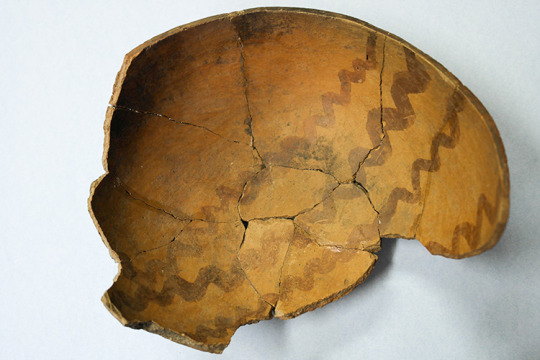
Cacao originated in the Amazon and was being grown in Chiapas by 1900 BCE. In 2011, cacao residue was found on pottery from Chaco Canyon, New Mexico. Then cacao was found on “Abajo Red on Orange” pottery in Utah in 2013. The pottery was tested to 780 CE. This adds to the story of extensive trade in cacao, scarlet macaws, pyrite mirrors, and turquoise, among other items, between Mesoamerica and the Southwest, which included repeated migrations. A new group of researchers are now testing pottery from areas near the site of the original cacao residues find in Utah. They have found mug bases, corrugated jar bases, white ware bowls and Abajo red-pon-orange pottery with cacao residue at three different sites within 10 miles of the original find, thus validating the original find.
Natural History Museum of Utah has the report here with nice photos;
https://nhmu.utah.edu/chocolate;
Mike Ruggeri’s Aztlan World
http://mikeruggerisaztlanworld.tumblr.com

Researchers from Denmark have taken samples from nine former lake beds in British Columbia and radio carbon dated the sediments. In the deepest layers from 13,000 years ago, they found no evidence of life in the area of the “ice free corridor” First Americans would have used to come to the New World. The area was naked and barren at 13,000 year ago. At the 12,600 years ago layer, they found traces of bison, hare and sage brush. So the area was not open to human travel at 13,000 years ago. There was a physical corridor, but it would be 400 years before humans could have traveled that corridor. So people entering the Americas could not have done so unless they traveled along the Pacific Coast. We know that people with stone tools had populated the Americas before 13,000 years ago. Before 12,600 years ago, there was no wood for fuel and tools, game animals for food, clothing and shelter in the so called ice free corridor. So the Clovis Culture that had established itself in the Americas by 13,000 years ago, had to have arrived by way of coastal travel by canoes. There were earlier Pre-Clovis peoples who arrived by the same coastal route at Monte Verde in Chile and Paisley Cave in Oregon before the arrival of the Clovis Culture immigrants 1,500 years before the arrival of the Clovis people.
The Daily Mail has the story and photos here;
http://dailym.ai/2boeqp7
Mike Ruggeri’s Pre-Clovis and Clovis World
http://bit.ly/11wqze5
Mike Ruggeri’s Pre-Clovis and Clovis World Magazine
http://bit.ly/1uAWdvk
Mike Ruggeri’s Pre-Clovis and Clovis News on Tumblr
http://mikeruggerispreclovisnews.tumblr.com
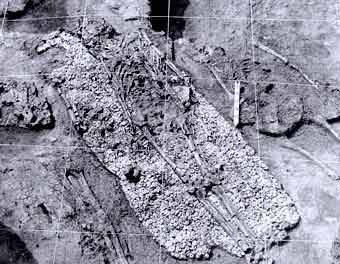
Researchers have analyzed the “beaded burial” at Cahokia and have found that the burial contains both males and females of high status, and not just males. Mound 72 had five mass graves, each containing 20-50 bodies, 270 bodies in all. The burials date to 1000-1200 CE. Twelve of the bodies are associated with a shell design in the shape of a bird. It was assumed that this meant the burials were of male warriors of chiefs. The new research found that the beaded burial area contained 12 bodies and not 6 bodies and that the 2 central bodies are of a male and a female. Other male and female pairs have now been found. The researche is published in American Antiquity. This puts a new light on the role of females at Cahokia.
PhysOrg has the report here;
http://phys.org/news/2016-08-fresh-burials-mass-graves-story.html
Mike Ruggeri’s Moundbuilders/Ancient Southwest News on Tumblr
http://mikeruggerisancientnorthamerica.tumblr.com
Mike Ruggeri’s Ancient Southwest/Mound Builders News Magazine
http://bit.ly/16PP9jH

Researchers have found a campsite dated to 10,300 BCE in the Utah desert salt flats. There is a hearth, spear point, and tobacco seeds, possibly the earliest evidence of tobacco use in North America. There had been no evidence of the use of tobacco in North America past 3000 years ago. Bones of ducks and geese were found in the trash. The inhabitants were carrying their big game tool kits. The spear point was adapted for big game hunting. The team had found 1000 large points nearby in 2015. The remains contained elephant residue. At the time of this site, the Utah salt flats were wetlands with rivers and lakes. The inhabitants hunted mammoths and giant bison. The tobacco seeds are a mystery. Where did they come from?
Western Digs has the report here;
http://westerndigs.org/ice-age-hunting-camp-replete-with-bird-bones-and-tobacco-found-in-utah-desert/
Mike Ruggeri’s Ancient Americas News on Tumblr
http://michaelruggeriancientamericas.tumblr.com

Archaeologists in Texas have uncovered 90 stone tools that date back 16,700 years, along with human teeth, and 160,000 flakes from the tool making process at the Gault Site. The teeth are from a young adult female. The teeth have been sent to a lab for analysis. The stone tools are completely different from Clovis tools. And so are the flakes. To prove the dating assertion, the soil the stone tools were found in was tested using optically stimulated luminescence dating, and the dates showed an age of 13,200-16,700 years old. Radiocarbon and relative dating of the artifacts were in agreement with these dates. The team presented their findings at the 2015 meeting of the Plains Anthropological Conference.
Western Digs has the news here with photos;
http://westerndigs.org/16000-year-old-tools-discovered-in-texas-among-the-oldest-yet-found-in-the-west/
Mike Ruggeri’s Pre-Clovis and Clovis World
http://bit.ly/11wqze5
Mike Ruggeri’s Pre-Clovis and Clovis World Magazine
http://bit.ly/1uAWdvk
Mike Ruggeri’s Pre-Clovis and Clovis News on Tumblr
http://mikeruggerispreclov
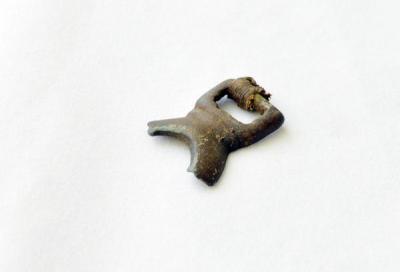
Several bronze and copper objects found in Alaska are the first evidence of metal trade with Asia in Pre-Columbian times. They are smelted alloys made in Eurasia and traded from Siberia to Alaska. Two of the items, a bead and buckle, are heavily leaded bronze dated to 1100-1330 CE. What was a backwater area of Alaska was engaging in trade with Siberia. The buckle could have been part of a horse harness in use in China around 1100 CE.
EurekAlert has the story here;
http://www.eurekalert.org/pub_releases/2016-06/pu-owm060716.php
Mike Ruggeri’s The Ancient America’s Breaking News
http://bit.ly/UbLO7x
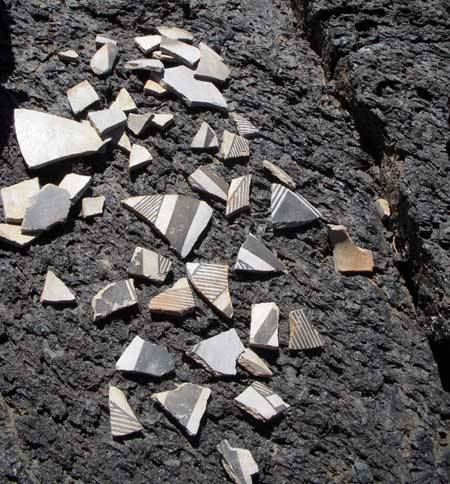
Archaeologists in New Mexico have uncovered a village dated to around 1100 CE that has ties to the Chaco complex. It contains some 120 sites and a two story great house with 85 rooms. It is a mixture of Chaco and independent styles. The stonework is of volcanic black rock, and there are intricate trails leading outwards from it. The settlement is called Las Ventanas. The Great House is built along the lines of Chacoan architecture, but the structures are not built of sandstone, like Chaco, but of black volcanic rock. Some of the ceramics showed affinities to the south as well as to Chaco. The trails cover 62 miles in length, and do not appear to lead anywhere. This is similar to the trails found at Chaco. So they were ritual features. Many artifacts were placed along the trails and look like they were related to lava flow ritual.
Western Digs has the story here with good photos;
http://bit.ly/1rO9AIz
Mike Ruggeri’s Moundbuilders/Ancient Southwest News on Tumblr
http://mikeruggerisancientnorthamerica.tumblr.com

Radiocarbon dating at the Page-Ladson sinkhole site in Florida has shown that ancient tools, including a knife, alongside extinct animal bones were Pre-Clovis, dated to 14,550 years ago. They found a mastodon tusk with cut marks made by humans using stone tools. This proves that these extinct mastodons were not wiped out by human hunters as quickly as believed, but lived alongside of them for 2000 years. The artifact dating, stratigraphy dating and other scientific dating is unequivocal for Pre-Clovis. 71 samples of wood all matched at being 14,500 years old and they were found in the dated stratigraphy layers as matching.
The Daily Mail has good photos with the story;
http://dailym.ai/228WaDy
The LA Times includes a video with the story;
http://lat.ms/1Wx6SEp
Mike Ruggeri’s Pre-Clovis and Clovis World
http://bit.ly/11wqze5
Mike Ruggeri’s Pre-Clovis and Clovis World Magazine
http://bit.ly/1uAWdvk
Mike Ruggeri’s Pre-Clovis and Clovis News on Tumblr
http://mikeruggerispreclovisnews.tumblr.com
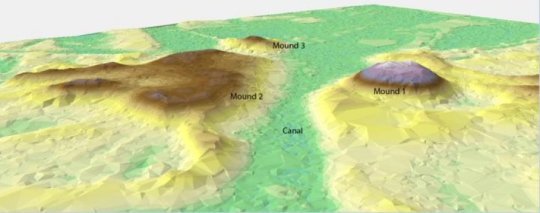
Researchers have been working on the artificial islands constructed by the Calusa culture at Mound Key and Vineland in Florida. The Calusa were terraforming islands from heaps of shells, bones and midden. Researchers used coring, test and block excavations and radiocarbon dating. They have found that some of the older material was on top of younger material, indicating the Calusa were reworking their deposits to create new landforms. The tallest of the mounds is 32 feet above sea level. This would have taken hundreds of millions of shells. When sea levels fell, the Calusa abandoned the island. When sea levels rose, they returned. The Calusa economy was based on fish, shellfish and seafood. 1000 people would have lived on Mound Key. The researchers also studied the second largest artificial island city, Vineland. The Calusa built canals, water storage facilities, and traded widely. The researchers will continue at these sites during the summer. The research is published in PLOS One.
“From Shell Midden to Midden-mound: The Geoarchaeology of Mound Key, an Anthropogenic Island in Southwest Florida, USA,” PLOS One, journals.plos.org/plosone/article?id=10.1371%2Fjournal.pone.0154611
PhysOrg has the report here;
http://phys.org/news/2016-04-shells-interdisciplinary-unraveling-mysteries-calusa.html
Mike Ruggeri’s The Ancient America’s Breaking News
http://bit.ly/UbLO7x
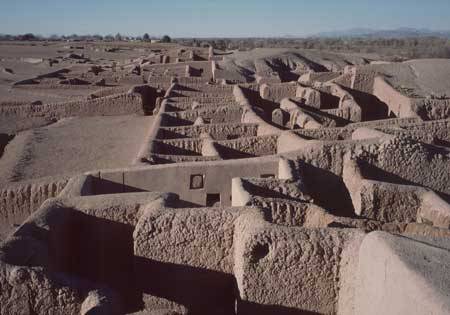
Researchers are studying the fossilized teeth of ancient inhabitants of Casas Grandes (Paquime), in Chihuahua. The first conclusive evidence of the use of corn beer in the ancient Southwest has been found in the teeth of the inhabitants. Paquime housed 3000 people at its height in the 14th century. It was a major trading post between Mesoamerican and the Southwest. The tartar on the teeth of the dead traps elements that have been ingested and mineralize over time. 110 individuals remains were tested, buried between 700-1450 CE. 63 had mineralized remains. 10% of the samples yielded corn smut (huitlacoche), an edible fungus that is still a delicacy today. Three samples showed fermentation that would have been used to make chicha, a corn beer that was in use for 5000 years in Mesoamerica and South America. The fermented granules dated to 1200-1450 CE.
Western Digs has the report here;
http://bit.ly/1QKvN3j
Mike Ruggeri’s Aztlan World
http://mikeruggerisaztlanworld.tumblr.com
Mike Ruggeri’s Casas Grandes World Magazine
http://bit.ly/1ztd8vF
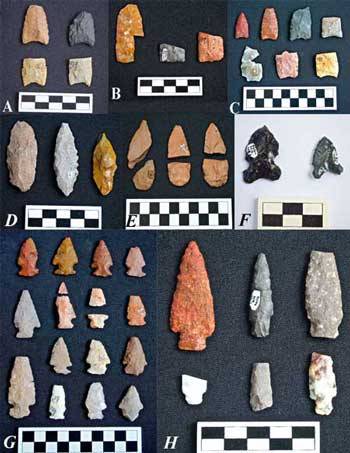
Archaeologists in northern Chihuahua have uncovered a 10,500 year old hunting camp. They have found 18,000 artifacts including stone flakes, cores, and hammers, along with 370 projectile points, and a dozen stone ovens. The 370 points represent 30 different styles from the Paleoindian to the Archaic. They found the remains of a teenage girl interred 3,200 years ago. Radiocarbon dates on the teeth of the girl date to 1360 BCE.
In the 1990’s, archaeologists had found the earliest remnants of corn in Chihuahua at the nearby site of Cerro Juanaqueña. The maize dated to 1150 BCE. If the girl is related to this culture, more can be known about the people of the region. Strontium isotope analysis of her teeth may yield information about where she was born and raised and her diet.
Western Digs has the report here;
http://westerndigs.org/grave-teenage-girl-southwest-earliest-farmers/
Mike Ruggeri’s Ancient Southwest Magazine
http://bit.ly/1AU3vwE
Mike Ruggeri’s Ancient Southwest/Mound Builders News Magazine
http://bit.ly/16PP9jH
Mike Ruggeri’s Moundbuilders/Ancient Southwest News on Tumblr
http://mikeruggerisancientnorthamerica.tumblr.com
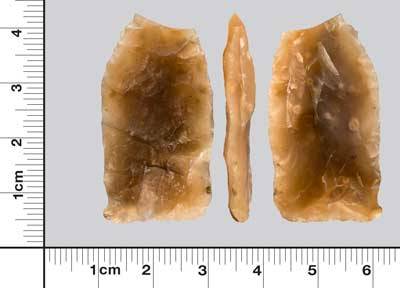
Archaeologists have found 19 sites in Nevada that were in use by hunter-gatherers 12,000 years ago. They uncovered stone points, biface blades and other artifacts at these sites. Clovis, Lake Mojave and Silver Lake points have been found in these caches. They used predictive modeling to find the sites. The know that human activity in this area are found near water and marshlands, and the shores of lakes and channels. So the archaeologists used predictive modeling and GIS technology for signs of Pleistocene-Holocene era life. They mapped with GIS, aerial photos and other tools, and pinpointed likely spots. The spots were then ground truthed. These new tools are now a proven method for finding ancient sites.
Western Digs has the report here;
http://westerndigs.org/nearly-20-stone-tool-sites-up-to-12000-years-old-discovered-in-nevada/
Mike Ruggeri’s The Ancient America’s Breaking News
http://bit.ly/UbLO7x
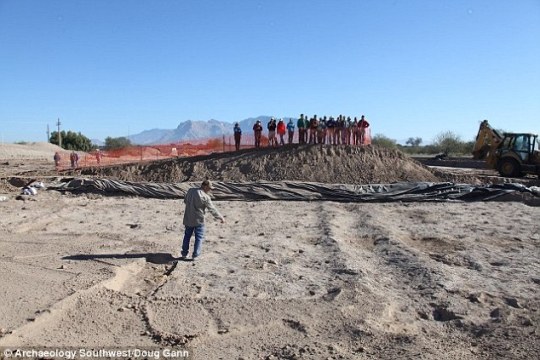
January 30, 2016
Archaeologists have found footprints of a family of farmers embedded in the soil at a site in Tucson dating to 500 BCE, making these the oldest footprints ever found in the Southwest. A flash flood at the time had covered these prints over, preserving them. The farmers were ancestors of the Hohokam culture who built elaborate irrigation canals. The Hohokam grew cotton, tobacco, maize, beans and squash. The footprints show adults, children and a family pet walking across their fields. They are making 3D scanning videos of the prints and casts of the footprints before they are covered over to build a highway. The site also shows evidence of irrigation canals and earthworks. The prints show the farmers moving from canal gate to canal gate and building mud dams to divert rain and river water to maize plants. Archaeologists will now study the soil nearby for futher evidence of these early farmers.
(My note; Footprints dated at more than 13,000 years ago have been found on an island off of British Columbia, and Tom Dillehay found human footprints at the site of Monte Verde in Chile that date to 1000 years before Clovis times. These are the first Pre-Clovis footprints found so far. The dates for these prints have been validated by all other researchers who have come to the site to verify the find.)
Daily Mail has the report here with many videos, 3D Scans and great photos;
http://dailym.ai/1ZV2lIE
Mike Ruggeri’s Moundbuilders/Ancient Southwest News on Tumblr
http://mikeruggerisancientnorthamerica.tumblr.com
Mike Ruggeri’s Ancient Southwest/Mound Builders News Magazine
http://bit.ly/16PP9jH

Archaeologist Steven Shackley at the UC Berkeley has done an analysis of spear and arrow points in the Hohokam region, and chemically analyzed thousands of obsidian pieces to find their origins. He has concluded that the style of the projectile points, ceramics, burial practices, rock art, tools and origin stories are Hohokam as far north as Colorado, Flagstaff, into New Mexico and California and down into Baja. The material connection to the Hohokam throughout this entire area is strong over 50,000 square miles. From 700-1300 CE, there is little evidence of large scale violence in this area. The Hohokam were a diverse multiethnic, multilingual society. Shackley’s analysis will be a point of controversy and debate as archaeologists continue to expand our knowledge of the entire ancient Southwest.
The Payson Roundup has the report here;
http://www.paysonroundup.com/news/2015/dec/30/how-far-did-hohokam-reach/
Mike Ruggeri’s
The Ancient Southwest
http://bit.ly/X1kCou

Desert Archaeology researchers have been working at the site of Las Capas in the Tucson Basin for several years. They have found an extensive system of irrigated fields dating to 1200-800 BCE. Some maize at the site has been dated at 2100 BCE. 53 pit houses thousands of storage pits and 113,000 artifacts, including human remains have been uncovered so far. The fields would have sustained a community of 125 people. The inhabitants hunted with atlatls. Remains of deer and sheep have been found, but most of the animal remains are rabbits. They ate rabbit stew, amaranth and mesa cakes made from maize. There were human remains which showed violence; skull fractures and defensive wounds. Archaeology Southwest has published a book on the findings.
The Arizona Daily Star has the report here;
http://tucson.com/news/blogs/scientific-bent/the-early-gastronomes-of-tucson/article_a590ea11-2768-53d2-ad77-df54a5ce6516.html
Mike Ruggeri’s
The Ancient Southwest
http://bit.ly/X1kCou
Mike Ruggeri’s Ancient Southwest Magazine
http://bit.ly/1AU3vwE
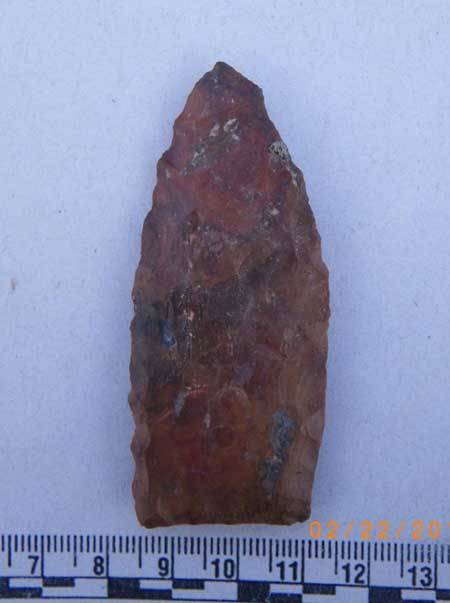
Archaeologists have found 9,000 artifacts representing 11,500 years of history. 8,830 stone tools, flakes, ceramics, bone and a Clovis blade made from jasper have been uncovered in the Mojave desert. They also perused older research reports from this area, which is on a Marine base. 19 Western Stemmed Tradition points and 14 Pinto points had been found in the area, dating to 4000-6,500 BCE. Most of the artifacts uncovered by this team date to 5000-7000 BCE. The team has requested that the two most productive sites be placed on the Department of the Interior’s National Register of Historic Places.
Byerly and his colleagues report their findings in the journal Paleoamerica.
Byerly, R., & Roberson, J. (2015). Late Pleistocene to Middle Holocene Archaeology in the Mojave Desert: Recent Discoveries in Twentynine Palms, California PaleoAmerica, 1 (2), 197-201 DOI: 10.1179/2055556315Z.00000000020
Western Digs has the report here;
http://westerndigs.org/nearly-9000-artifacts-uncovered-in-california-desert-spanning-11500-years-of-history/
Mike Ruggeri’s Pre-Clovis and Clovis World Magazine
http://bit.ly/1uAWdvk
Mike Ruggeri’s Pre-Clovis and Clovis News on Tumblr
http://mikeruggerispreclovisnews.tumblr.com

Archaeologists have found two infants buried with a stone cutting tool and animal antlers with spear points in an 11,500 year old burial at the Upward Sun River site in Alaska. They belong to two genetic groups. Their genetic makeup lends itself to the idea that humans lived in a dry area that existed between Siberia and Alaska 30,000 years ago called Beringia. Humans may have spent as many as 10,000 years in Beringia before moving rapidly into America 15,000 years ago. Since the two lineages represented by the two infants lived so far north so long ago, their genes support the “Beringian Standstill Model.” The genetic variation of the two may be showing that the 10,000 year hiatus in Beringia gave rise to genetic diversity before they came into the Americas. The lineages of the infants are not found in Siberia or Asia, so they must have drifted from Asiatic groups during those 10,000 years in Beringia.
Genetic material has been found at eight sites in North America older than 8,000 years. In these eight sites, all five major lineages of Native Americans are present, indicating the the Beringian population gave rise to all of the lineages. One of the two infants is the ancestor of tribes in Arizona, California, Bolivia, Tainos and in Illinois. The other infant is the ancestor of Washington, Arizona, California and Peruvian tribes.
(my note; The idea is that populations in Beringia could not move into the Americas during those 10,000 years of the standstill due to a huge untrekkable area of ice that stood between them and the Americas. This still does not preclude the idea that other Asiatic peoples escaped this standstill by taking a canoe route down the Pacific Coast in earlier times. The Pre-Clovis finds at Monte Verde, Chile and Paisley Cave in Oregon would be examples of these earlier arrivers).
My Pre-Clovis and Clovis web site has a section on Beringian studies, published before this research, as well as on Paisley Cave and Monte Verde, for further elucidation.
Mike Ruggeri’s Pre-Clovis and Clovis World
http://bit.ly/11wqze5
The Daily Mail has the report on the two infants with their usual great illustrations;
http://dailym.ai/1PbgKON
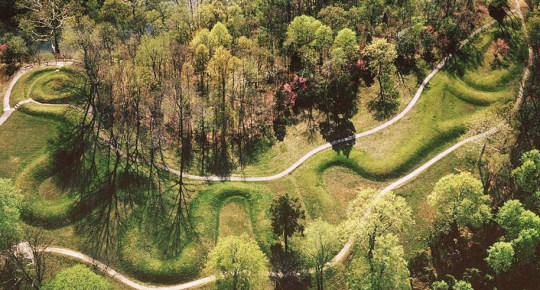
Researchers have investigated the dental isotopes of individuals from six Fort Ancient, Ohio sites, and one site in Indiana. They studied 152 individuals. They found that 18% of the population studied are potentially non-local. The Turpin Site, the most Mississippian of the sites studied, had the most non-local individuals. The study also shows that maize eating in the Fort Ancient culture was an abrupt new dietary adaptation. This is linked to the arrival of Mississippians, possibly from Cahokia. The new arrivers may have come as missionaries, captives or marriage partners.
The research is published in the Journal of Archaeological Science
The great Bradley T. Lepper Publishes this synopsis in the Columbus Dispatch;
http://www.dispatch.com/content/stories/science/2015/10/25/1-did-missionaries-influence-earliest-ohioans.html
Mike Ruggeri’s Adena and Hopewell World
http://bit.ly/Mj7I1L
Mike Ruggeri’s Adena, Hopewell, and Fort Ancient Cultures Magazine
http://bit.ly/1966ruf

Archaeologists at the Pig Point site in Maryland, which dates back to 7,205 BCE, are now finding evidence of a vast settlement surrounding the ceremonial core of the site. 450 test pits over a quarter mile area almost all had artifacts. They have already found projectile points and pottery going back to 6,000 BCE. In 2012, they found a burial grounds with 1,000 individuals spanning thousands of years. A new projectile point find dates back to 8,000 BCE. 14 new sites have been uncovered in the last few seasons. As the sea rises along the coast, much of this archaeology will be under water.
The Capital Gazette has the news here with a video;
http://www.capitalgazette.com/news/ph-ac-cn-pig-point-plus-1011-20151011-story.html
Mike Ruggeri’s The Ancient America’s Breaking News
http://bit.ly/UbLO7x
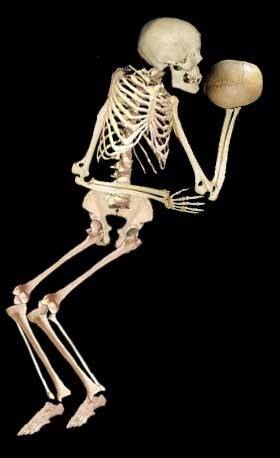
A site in California, Marsh Creek Village, that stretches back 7,000 years has been found with unusual burials. Six individuals were decaptitated and six others with an extra skull by their sides. In two graves, the skulls have been crafted into polished bowls. There are no signs of violence. The site was uncovered in 2002. They found 500 burials, and artifacts dating back 7,000 years. These were people who lived as sedentary hunter-gatherers, eating acorns, seeds, fish and small game. The ones found with no skulls and those with extra skulls buried with them are not unique. Researchers have studied the chemistry of the teeth and bones of 200 individuals at the site. The burials with the skull ritual had the same strontium signature in their teeth as the others at Marsh Creek. And there was no sign of violence or injury. The skull ritual may have been related to kinship and ancestor worship. Often, in these kinds of cases, bones are made into flutes and whistles. The teeth in two of these special burials show a sharp drop in nitrogen in their diet at 12-21 months of age. Both had been weaned from their mothers suddenly and at a young age. Perhaps the mothers died early, and the two were adopted. Perhaps the skulls were re-united with the mother in death.
These findings are posted in the journal American Antiquity.
Western Digs has the report here with photos;
http://westerndigs.org/severed-heads-skull-bowls-found-in-california-graves-were-tributes-not-war-trophies-study-finds/
Mike Ruggeri’s The Ancient America’s Breaking News
http://bit.ly/UbLO7x

A mass grave of seven men dated to 850 CE was uncovered in the construction of a shopping mall near San Francisco. They range in age from 18-40. They had severe head wounds, broken limbs, and obsidian weapons in their remains. Chemical analysis shows they were far from home. This is another example of the violence among hunter-gatherers in the region. This was an area of high population density during this era. The researchers set about reconstructing the life history of the men. By studying the chemistry of their teeth, they found that the men spent their lives together, and differed completely from the other burials in the Amador Valley. They lived further inland and ate freshwater fish. Their chemical signature placed them to the southeast in the San Joaquin Valley. The researchers then studied the mitochronial DNA of the men. It was found they came from at least four different families. They will study the remains further looking for tobacco or hallucinogenic use, and possible infections or diseases.
Eerkens and his colleagues report their findings in the American Journal of Physical Anthropology.
Western Digs has the report here;
http://westerndigs.org/mass-grave-found-in-california-reveals-prehistoric-violence-against-outsiders/
Mike Ruggeri’s Ancient Americas News
http://michaelruggeriancientamericas.tumblr.com
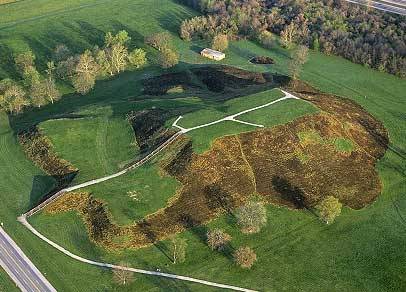
Researchers studying the largest mound at Cahokia, Monk’s Mound, are speculating that the moound may have been built very quickly. It has been believed that the mound took 250 years to build in 14 stages. the new research took samples from the mound when repairs on the mound were being done in 2005. They looked at plant remnants and found the non-food plants were annuals that live only one to five years. The evidence suggests that construction was continuous. And the plant remains point to Monk’s Mound being built in only 20 years. The unburned remains of the plants were well preserved and not decayed as they would have been over 250 years. And they also found that parts of the mound were constructed with whole sod blocks and not basktfuls of soil.
Lopinot and Schilling report their findings, with colleagues Gayle Fritz and John Kelly of Washington University, in the Midcontinental Journal of Archaeology.
Western Digs has the story here;
http://westerndigs.org/americas-largest-earthwork-cahokias-monks-mound-may-have-been-built-in-only-20-years-study-says/
Mike Ruggeri’s Moundbuilders/Ancient Southwest News on Tumblr
http://mikeruggerisancientnorthamerica.tumblr.com
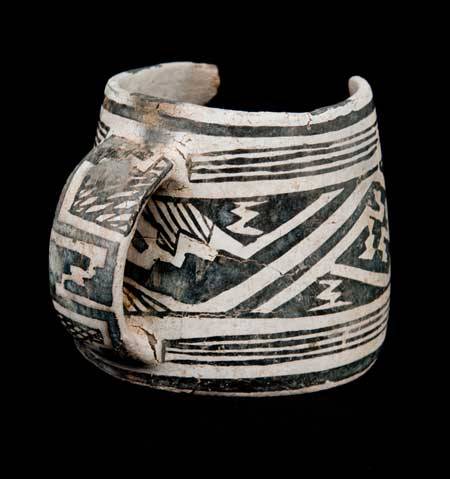
Researchers analyzed 177 samples of pottery from ancient Colorado to Chihuahua spanning 750-1400 CE. 22% of the ceramics contained either cacao or the “black drink” that was made from yaupon holly. Yaupon holly is highly caffeinated. Both ingredients were grown in Mesoamerica and the Gulf Coast. It does not grow in the Southwest. The sites included Chaco’s Chetro Ketl, Snaketown in Arizona and Windy Knob in Colorado. This study shows prolonged and sustained contact with Mesoamerica.
Crown and Hurst report their findings in the Proceedings of the National Academy of Sciences.
Western Digs has the story here;
http://westerndigs.org/use-of-cocoa-black-drink-widespread-in-pre-contact-southwest-study-finds/
Mike Ruggeri’s Aztlan World
http://mikeruggerisaztlanworld.tumblr.com

Researchers have been studying mass sacrifices at the site of Cahokia which took place between 1000-1100 CE. 270 bodies were found in a mass grave at Mound 72, mostly young women. They were killed by strangulation or bloodletting. And there was a separate group of 39 men and women in a separate deposit that evidenced brutal fractures, stone points embedded in their bones, decapitation. The researchers have found that all of the victims came from Cahokia or very nearby. The 39 dead who died brutally may have been part of an isolated group at Cahokia, since they differ from those in the larger mass grave in some respects. They analyzed 203 teeth from 109 individuals. They studied 24 individuals in a mass burial mound dated to 1000 CE, 50 individuals at another burial site dated to 1050 CE, and another two-layered mass burial containing peaceful burials on top and mutilated individuals beneath. They were lined up and pushed in. The strontium levels in the teeth of the dead shows most were local to Cahokia. A few were not local in each burial site. But the brutally killed were all local to Cahokia.
These findings refute theories that the sacrificed were tributes from other areas outside of Cahokia or war captives.
The team reports their findings in the American Journal of Physical Anthropology.
Western Digs has the report here;
http://westerndigs.org/victims-of-human-sacrifice-at-cahokia-were-locals-not-captives-study-finds/
Mike Ruggeri’s Moundbuilders/Ancient Southwest News on Tumblr
http://mikeruggerisancientnorthamerica.tumblr.com
Mike Ruggeri’s Ancient Southwest/Mound Builders News Magazine
http://bit.ly/16PP9jH
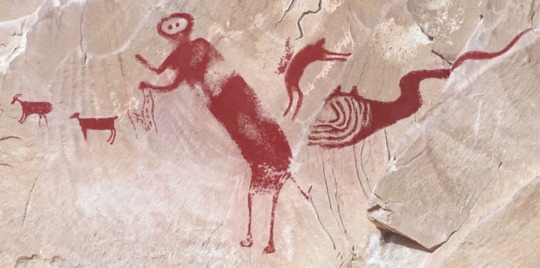
Rock art researchers investigating Fremont rock art at Utah’s Black Dragon Canyon have deciphered strange rock art images which defied explanation till now. Researchers in the past said that the images looked like an ancient animal. The researchers used cutting edge technology; DStretch and a portable X-ray fluorescence device. They found that the paintings show five separate images, including a tall bug-eyed person, a smaller person, a sheep, a dog and a serpentlike figure.
The study was published in the August issue of the journal Antiquity.
http://www.livescience.com/51886-winged-monster-rock-art-deciphered.html
Mike Ruggeri’s Moundbuilders/Ancient Southwest News on Tumblr
http://mikeruggerisancientnorthamerica.tumblr.com
Mike Ruggeri’s Ancient Southwest/Mound Builders News Magazine
http://bit.ly/16PP9jH
August 18, 2015
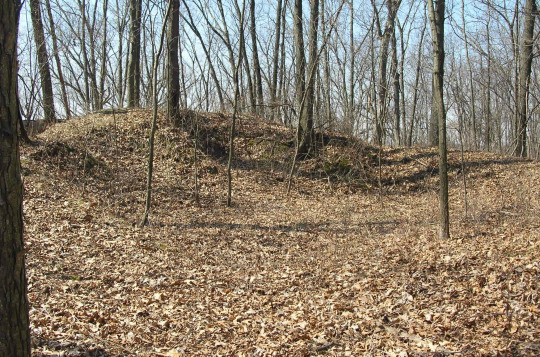
Illinois Archaeologists have been excavating at the Collins Site in Illinois. The site is dated to 1000-1100 CE. During their time, the bow and arrow was introduced along with maize cultivation. The huge site of Cahokia boomed during this time, and Cahokian influence can be seen at the Collins site in pottery and buildings. There are seven mounds at the site, including a platform mound. The platform mound is called the Indian Springs Mound, and was probably a crematory site. Burnt red cedar, a ceremonial wood, and a scaffold with the remains of five bundled individuals were found there. The site was covered over after this. The site may have been temporary, used for feasting and ceremonies. The site was abandoned in 1100 CE and the inhabitants moved 25 miles to the Caitlin site.
The Canton Daily Ledger has the story here;
http://www.cantondailyledger.com/article/20150807/NEWS/150809687/-1/sports/?Start=1
More on the work at the Collins site here;
http://www.isas.illinois.edu/news/collins_site_reconstruction.shtml
Mike Ruggeri’s Ancient Americas News on Tumblr
http://michaelruggeriancientamericas.tumblr.com
Mike Ruggeri’s Ancient Southwest/Mound Builders News Magazine
http://bit.ly/16PP9jH

August 3, 2015
Archaeologists have found that 345 fiber wrapped pouches at Antelope Cave, Arizona dated to 1,200 years ago, contain wild tobacco. They were originally found in the 1950’s and left unexamined till now. This is further proof that Ancestral Puebloans chewed tobacco. These pouches have been found from Texas to California, but their purpose was unknown until now. Their placement suggests that the tobacco was used informally and not for ceremonial purposes.
Western Digs has the story here with a photos;
http://westerndigs.org/1200-year-old-pouches-found-in-arizona-cave-contain-prehistoric-chewing-tobacco-study-finds/
Mike Ruggeri’s Ancient Southwest/Mound Builders News Magazine
http://bit.ly/16PP9jH
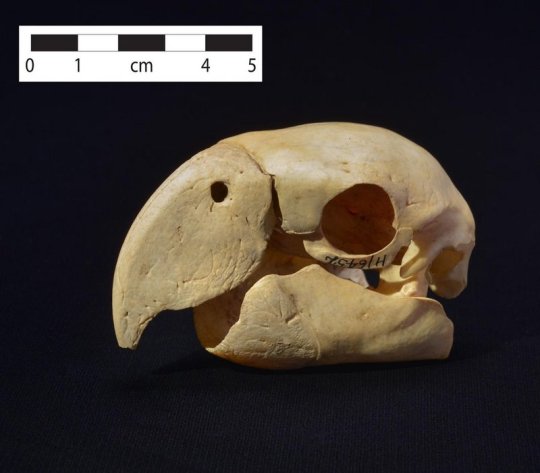
June 23, 2015
New radio-carbon dating of bird remains in a Chacoan site in New Mexico finds that long distance trade networks began 150 years sooner than thought in that area. This means that social and political hierarchies emerged sooner than thought. The trade in macaw feathers from Mesoamerica started in the 9th century, it not appears. The macaw, chocolate and turquoise trade helped facilitate the new hierarchy. The earliest dates that had been established for the Macaw trade was 1040 CE. Two important burials at Chaco took place at 775-875 CE. And Macaw feathers were found with these burials. 30 macaw remains have been found at Pueblo Bonito, with 14 of them being found in one room, Room 38, which appears to have been an aviary. 12 of 14 macaws sampled in the new study pre-date the 1040 CE date, and half of them dated to 800-900 CE.
Popular Archaeology has the report here with great photos;
http://popular-archaeology.com/issue/summer-2015/article/scarlet-macaw-skeletons-point-to-early-emergence-of-pueblo-hierarchy
The entire research report can be read here;
http://www.pnas.org/content/early/2015/06/17/1509825112.full.pdf?with-ds=yes
And more on the long distance trade networks can be found here;
Mike Ruggeri’s The Casas Grandes World and the Turquoise Road
http://bit.ly/X1jzF9

June 18, 2015
Penn State Researchers are studying are studying the transition between the Coles Creek Culture and the later Plaquemine Culture in Mississippi at the Smith Creek sites. They have found arrowheads, animal bones, pottery. Mounds at the two sites they are excavating were constructed by the Coles Creek people from 800-1000 CE. One mound was a temple foundation, another was for a burial. White sand was brought to build one layer of a mound. A human skull was found, but the neighboring tribal leaders asked that the skull not be studied or excavated. The later Plaquimine culture, who took up residence there, grew corn and amaranth, squash, pecans, sunflower seeds, fish, turtle and deer. The sites at Smith Creek show the transition between the hunting and gathering Coles Creek Culture and the sedentary Plaquemine farming culture.
The Advocate has the report here with a good slide show;
http://theadvocate.com/news/12677031-123/mississippi-valley-archaeological-site-reveals
And Penn State has a larger blog about the ongoing work at the site;
http://www.penn.museum/blog/tag/smith-creek-archaeological-project/
Mike Ruggeri’s Moundbuilders/Ancient Southwest News on Tumblr
http://mikeruggerisancientnorthamerica.tumblr.com
Mike Ruggeri’s Ancient Southwest/Mound Builders News Magazine
http://bit.ly/16PP9jH
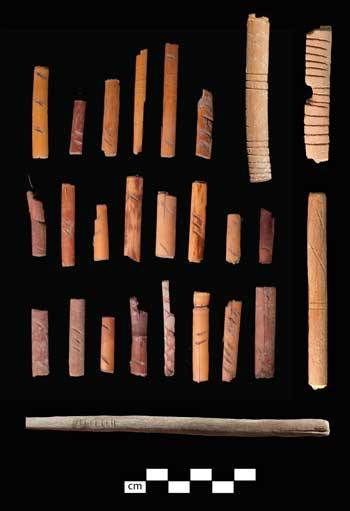
May 18, 2015
Researchers exploring what is named Cave 1 in Utah have found dice, hoops, carved sticks and other artifacts related to gambling. They project they will find 10,000 more artifacts of this kind in the cave. The cave has already yielded butchered bison and elk bones and hundreds of moccasins. The artifacts date to the late 1200’s CE. The culture that lived there is called the Promontory Culture. These people left the Canadian Subarctic to migrate to the Southwest. Despite the turmoil and abandonment that was taking place at other sites at this time, the Promontory Culture was thriving. Dice was probably largely a womens game for personal property or chores. Men’s gambling was often a replacement for hostility between rival groups. Games were probably played with the nearby Fremont people. There are stories of men losing everything, food, their clothes, and losing their family as slaves, even their own scalps. There is a die made from a beaver tooth that came from the Oregon coast, indicating wide spread trade relationships. A spiral incised stick is similar to ones found in British Columbia. Many of the artifacts bear the imprint of their Arctic origins.
Western Digs has a very complete report with many photos here;
http://westerndigs.org/dice-gaming-utah-cave-prehistoric-gambling/
Mike Ruggeri’s Moundbuilders/Ancient Southwest News on Tumblr
http://mikeruggerisancientnorthamerica.tumblr.com
Mike Ruggeri’s Ancient Southwest/Mound Builders News Magazine
http://bit.ly/16PP9jH

May 8. 2015
New research published in “Building the Past: Prehistoric Wooden Post Architecture in the Ohio Valley — Great Lakes” edited by Brian Redmond and Robert Genheimer includes new research on the Moorhead Circle, the center of the Fort Ancient Earthworks built 2000 years ago. The entrance to the circle was through a gap in a ring of posts paved with limestone slabs. Older pavements are below it. There is a central pit filled with blood-red clay. And there is a central structure 50 feet long and 40 feet wide which may have been a ritual sanctum. There are concentric rows of 15 trenches filled with gravel and sand, which may have been for an audience. The circle went through a sequence of termination rites, and the large posts around the site were removed at 150 CE. The main structure was in use till 250 CE, and then was buried under tons of gravel. The Hopewell must have believed that these sanctums contain enormous power and it takes enormous efforts to terminate them.
(my note, through the Ancient Americas, ritual termination of sites and structures is a recurring phenomena).
The great Bradley Lepper has the report here;
http://www.dispatch.com/content/stories/science/2015/05/03/1-author-examines-ceremonial-heart-of-earthworks.html
Mike Ruggeri’s Adena, Hopewell, and Fort Ancient Cultures Magazine
http://bit.ly/1966ruf
(click on titles or pictures to open articles)
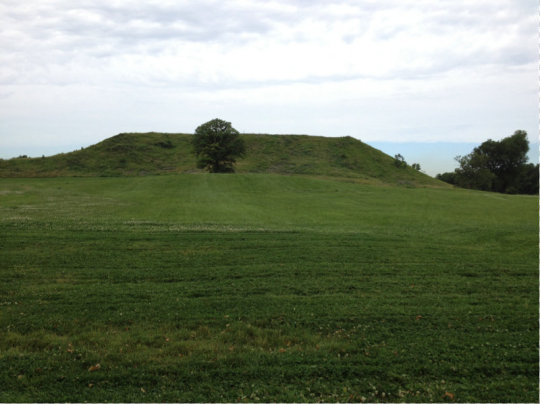
May 5, 2015
New evidence at Cahokia taken from lake bottom sediment cores dating back 2000 years show evidence of eight major floods in the central Mississippi river valley. Cahokia became a major metropolis during an arid and flood free period. The research team collected cores from two lakes to see if the information was consistent. By 900 CE, people in the Cahokia area were cultivating maize and the population exploded. Larger buildings and structrues were constructed. But at 1200 CE, there was a major flood and a population decline. A defensive wall was built around Cahokia and other material changes. By 1400 CE, Cahokia was deserted. The cores show a rise in the Mississippi by 33 feet above base elevation, which would have flooded out crops and food stores.
The research is published in the Proceedings of the National Academy of Sciences.
Popular Archaeology has the report here;
http://popular-archaeology.com/issue/spring-2015/article/cahokia-s-rise-and-fall-linked-to-river-flooding
Mike Ruggeri’s Ancient Southwest/Mound Builders News Magazine
http://bit.ly/16PP9jH
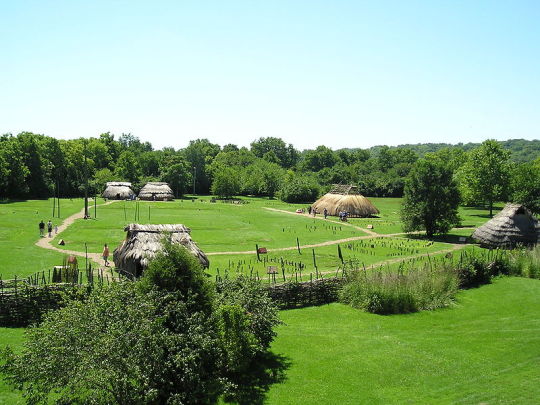
April 8, 2015
The Fort Ancient Culture of Ohio, Kentucky, Indiana and West Virginia had a rapid increase in maize production, and then declined. Researchers carried out isotopic analysis of human teeth from burials dated at 1000 CE onwards. There was an influx of Mississippian peoples in the area, spreading Mississippian agricultural and cultural traditions to the east. Mississippian style housing and ceramics have been found at Fort Ancient sites.
The study is been published in the Journal of Archaeological Science.
*Cook, Robert A. and Price, T. Douglas, Maize, Mounds and the Movement of People: Isotope Analysis of a Mississippian/Fort Ancient Case, Journal of Archaeological Science, doi:10.1016/j.jas.2015.03.022
Popular Archaeology has the report here;
http://bit.ly/1DixePM

February 15, 2015
Bradley T. Lepper is looking at the Hopewell Interaction Sphere to try and understand its main components. The Interaction Sphere is primarily a mortuary-ceremonial and religious interaction sphere. Lepper now believes that the Interaction Sphere is primarily a network of pilgrimage centers. Followers brought exotic raw materials and finished craft items to places like the Hopewell Mound Group and the Newark Earth Works. The pilgrims would return home to spread the religious ideas and establish local centers for the main religious ideas to be promulgated. They would bring home bladelets made from Ohio flint ridge material as tokens of visitation.
Research is showing that Ohio Flint Ridge flint bladelets were an important symbol of the Hopewell Interaction Sphere. At Pinson Mounds in Tennessee, 25% of the bladelets found there were from Flint Ridge, Ohio. And another 20% possibly from Flint Ridge. At Ohio sites, the Flint Ridge bladelets dominate. Flint Ridge flint declined at the end of the Hopewell era.
Bradley Lepper’s excavations at Flint Ridge showed that it was quarried on an industrial scale and turned into bladelets. The quantity produced was far greater than local need. Lepper believes that they were made to distribute as souvenirs and pilgrims tokens rather than part of a trade network. They were valuable symbols of the pilgrimage to the large Hopewell sites. And the industry died when the Hopewell era ended even though the bladelets were very efficient and well made, as if the system of belief that supported their use had died.
To further develop the idea of pilgrimages and the transportation of exotic finished products to the main sites, Wright and Loveland published their research at the site of Garden Creek recently in the journal Antiquity. The Hopewell site of Garden Creek in North Carolina has three mounds and earthen enclosures. Fragments of mica and crystal quartz have been found there dating to the Hopewell era. The mica and quartz was probably shaped by craftsmen there into trade objects. But no finished pieces are found there, indicating the pieces were sent away exported. The finished products may have been taken to the great Ohio Hopewell sites as an act of religious devotion.
Bradley Lepper’s reports are here;
http://apps.ohiohistory.org/ohioarchaeology/the-hopewell-mortuary-ceremonial-interaction-sphere/
and here;
http://www.dispatch.com/content/stories/science/2015/02/15/01-theory-looks-at-how-ancient-goods-got-to-ohio.html
and here;
http://www.dispatch.com/content/stories/science/2014/12/07/01-flint-tool-disappeared-with-hopewell-culture.html
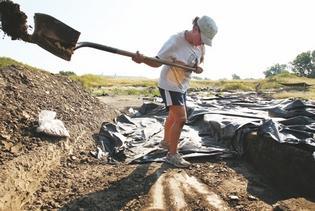
January 14, 2015
Archaeologists are continuing to excavate at the East St. Louis site. This site is the oldest and largest city north of the Rio Grande. It preceded the site of Cahokia, and continued contemporaneous with Cahokia. It lasted as a large city for 150 years, and it was at its largest at 1000 CE. It is now becoming clear that it was bigger than Cahokia. Like Cahokia, immigration to the site was large. This could have been the result of a religious movement. Pottery from Southern Missouri, Northern Arkansas, Oklahoma, Texas and Wisconsin has been found there. As time went on, immigrants adapted the local pottery style. The Illinois State Archaeological Survey has uncovered 500,000 objects at the site. Arrowheads from North Dakota, Arkansas, Louisiana, Mississippi and Wisconsin are among the items. The number of arrowheads means warfare. And at 1200 CE, the site was abandoned. There is evidence of drought, which may have led to war.
The Pekin Times had the story here; http://www.pekintimes.com/article/20150212/News/150219646
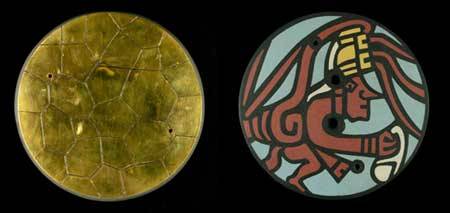
January 12, 2015
50 Pyrite mirrors were unearthed at Snaketown from the 1930s to the 1960s. They were found broken, burned and buried with humans in 16 graves. Ball courts, copper bells and macaw feathers were also found there. INAH began to study the mirrors intensely recently, starting in 2001. INAH found that the mirrrors were likely manufactured in central Mexico, each taking 110-160 days to create. They were worn by the elite as pectorals, belt ornaments, headgear. They were a portal to the underworld. The Snaketown mirrors date to 650-950 CE. The use of flakes of pyrite glued to sandstone with tree resin glue is a central Mexican craft. The Hohokam did not use pyrite. There are no Hohokam pyrite deposits.
Western Digs has the report here with a good photo;
http://westerndigs.org/mesoamerican-fools-gold-mirrors-found-in-arizona-reveal-ties-to-ancient-mexico/
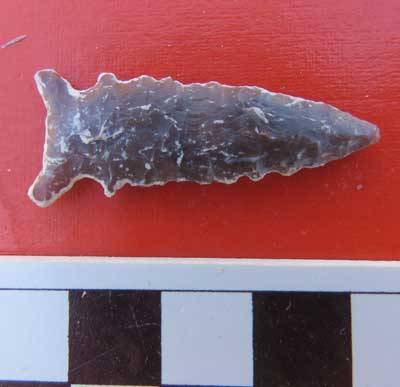
October 1, 2014
Archaeologists surveying near the Petrified Forest have found two villages dating to 700 CE. The first village had 50-75 structures lined with sandstone slabs, even though there is no stone nearby. Then, in the next season, the same team found another village with the same features about a mile away. Brown ceramics and stone points found there match the late Basketmaker period. The team found a smaller sandstone lined village with no pottery that probably pre-dates the two larger villages. These villages are transitional between hunting and gathering and more elaborate Chaco period sites. And the location of the sites may have been on a pilgramage path.
Western Digs has the story and photos here;
http://westerndigs.org/twin-1300-year-old-villages-discovered-in-arizona-sand-dunes/

August 15, 2014
Archaeologists have analyzed pottery sherds from a rockshelter in Colorado and found traces of salicylic acid, derived from willow bark. The residues are a 70%-93% match to salicylic acid. The sherds date to 586-692 CE. This may be the earliest physical evidence of this chemical, used in making modern day aspirin, in North America. The ethnographic record proves the widespread use of willow bark throughout the West and Great Plains. The sherd with the concentration of the pain killer may have been a “medicine pot” used for medicinal purposes.
Western Digs has the report here, with two photos;
http://westerndigs.org/prehistoric-pottery-found-in-colorado-contains-ancient-natural-aspirin/

August 10, 2014
From 1140-1180 CE, several centuries of relative peace in central Mesa Verde, Colorado, broke down into widespread violence. Washington State University and University of Colorado at Boulder archaeologists found that nine out of ten sets of human remains in this area had trauma to their heads or other parts of their body. In the northern Rio Grande, during the same time period, there was far less violence despite the same growth and population pressure. The northern Southwest went from 40,000 population in the mid 1200s to zero in 30 years. the northern Rio Grande people were able to join and identify with larger pueblo organizations and societies. They also had more commercial exchange, so that people were able to obtain what they wanted and needed. In the central Mesa Verde, there was less specialization. Trade and commerce appears to be a pacifying influence on populations. After 1160 CE, Chaco and its surrounding communities disappeared as a result of drought and an out migration of populations that left the remaining smaller populations there vulnerable to raids.
Past Horizons has the report on the study which will be published in American Antiquity;
http://www.pasthorizonspr.com/index.php/archives/08/2014/four-decades-of-violence-in-12th-century-mesa-verde